PinotFile: 8.18 July 15, 2010
|
Pinot Days San Francisco: Report from the Front LinesI recently returned home with renewed enthusiasm for Pinot Noir after three days at the 6th Annual Pinot Days San Francisco held June 25-27, 2010. Attendance was down this year, a testament to the economic doldrums, and some small, relatively unknown producers I spoke to were discouraged by the paucity of consumers interested in visiting their booths and trying their wines. That said, the people that did attend were mostly earnest pinotphiles who relished the added accessibility created by less crowds and enjoyed the time they had to spend with winemakers and winery owners. There were very few people out for an afternoon of slugging down copious amounts of Pinot resulting in very few inebriated attendees at the Grand Tasting.
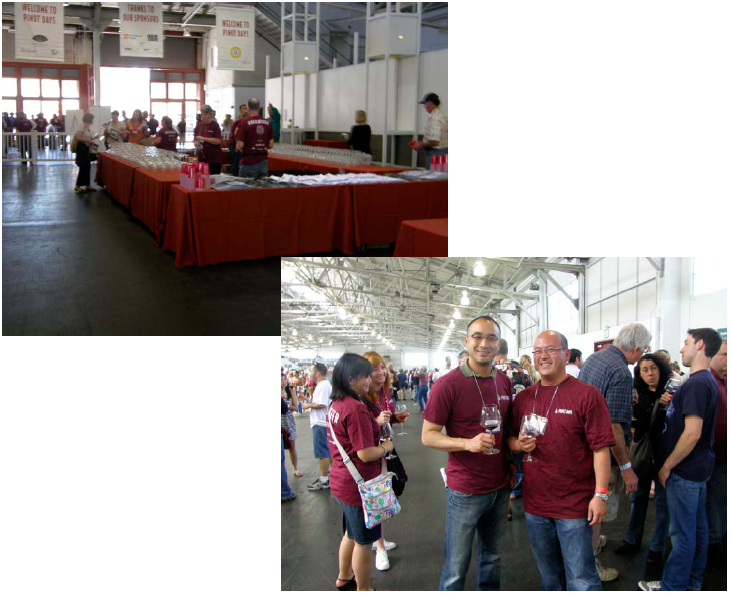 It was evident among the 216 predominantly California Pinot Noir producers pouring at the Grand Tasting that the quality of Pinot Noir has never been better. I overheard a number of comments like, “It’s hard to find a bad Pinot here!” And although there were a number of high profile wineries pouring (Alma Rosa, Buena Vista, Calera Wine Company, Domaine Serene, Goldeneye Winery, Hanzell Vineyards, Merry Edwards Winery, Pisoni Vineyard & Winery, Siduri Wines and Talley Vineyards), there were a number of big names conspicuously absent (Brewer-Clifton, Fiddlehead Cellars, Kosta Browne, Littorai, Loring Wine Co., Patz & Hall, Saintsbury, Sea Smoke, and Williams Selyem). Some excellent producers do not feel a large venue does justice to the tasting of their wines or simply do not need the added exposure (Dehlinger, du MOL, Kistler Vineyards, Marcassin, Rochioli, Rhys Vineyards) and do not participate in any large Pinot Noir tasting events. One disheartening aspect of large tasting events like the Pinot Days Grand Tasting is that a number of wineries send one of their sales and marketing staff to pour in place of the winemaker or owner. In some cases the substitutes are poorly informed about the wines and the consumer misses an opportunity to bond with the winery principals, many of whom are not easily accessible. I tasted nearly 250 Pinot Noirs over the three days at the Friday Trade Tasting (an invitation only event for the press and trade), Saturday’s three Focus Tastings, and Sunday’s Grand Tasting. Listed below are the producers and wines that caught my palate and are especially noteworthy. Be aware that these impressions are the result of quick samplings of the wines and do not represent the type of extended tasting that I offer in my regularly published wine reviews. With so many producers and so little time, I could not of course sample every winery’s offerings, and there are many, many outstanding vintners of Pinot Noir that are unintentionally omitted.
Trade TastingFriday, June 25, 2010 2008 Alma Rosa Santa Rita Hills Pinot Noir 14.1% alc., pre-release, screw cap. Composed of all the clones planted in the La Encantada Vineyard. Richard Sanford (photo below) is a tireless promoter of Pinot Noir and organic farming, and his newest project, Alma Rosa, launched in 2004, is offering increasingly impressive wines with each vintage. This is a very lovely wine that is soft and harmonious, offering a pleasing dark cherry and berry essence sparked by lively acidity. 2008 Alma Rosa La Encantada Sta. Rita Hills Pinot Noir Pre-release, screw cap. La Encantada is a 100- acre vineyard certified organic since 2000. 100% clone 667. One of the best wines I sampled on this day showing tremendous upside potential. Alluring aromatics, juicy and vivid fruit core, herb and oak nuances with balancing t n’ a, and impressive persistence on the finish.
 2007 Ampelos Lambda Sta. Rita Hills Pinot Noir 14.3% alc., $35, release in July 2010. Fourth harvest from estate vineyard. Unfined and unfiltered. Showing nice maturity from the additional bottle age. Darkly fruited, beautifully composed with admirable finesse and a showy, lingering finish. 2005 Arcadian Pisoni Vineyard Santa Lucia Highlands Pinot Noir 13.8% alc., $95. Owner and winemaker Joe Davis (photo below) is one of the most cerebral winemakers I know. He has a unique style, choosing to pick earlier than most other vintners, and crafting wines that need time to evolve, much like Burgundies. The wines are relatively high in acidity and more austere when young than many California Pinot Noirs. He only recently released his lineup of wines from the 2005 vintage which he feels was the best vintage ever for his label. His Pisoni bottling is highly unique among the several producers who source grapes from this famous site. More redder fruited than many Pisoni bottlings with more softness on the palate and more slippery tannins. Still has many good drinking years ahead. Also worth a look: 2006 Arcadian Jill’s Cuvée (Solomon Hills Vineyard) Santa Maria Valley Pinot Noir and 2006 Arcadian Fiddlestix Vineyard Sta. Rita Hills Pinot Noir (100% whole cluster). 2005 Arcadian Fiddlestix Vineyard Sta. Rita Hills Pinot Noir 13.5% alc., $60. Wines from this vineyard tend to be quite tannic, but Joe knows how to tame the beast. A very charming Pinot Noir with a full mouthful of flavors that fan out nicely on the persistent, mildly tannic finish.
 2007 Bink Wines Weir Vineyard Yorkville Highlands Pinot Noir 14.1% alc., pre-release, $40. Partners and winemakers Deborah Schatzlein and Cindy Paulson produce a single Pinot Noir from the Yorkville Highlands appellation. The 7-acre Weir Vineyard is farmed by Bill and Susan Weir and includes a diverse planting of Pinot Noir clones including Pommard from Rochioli Riverblock Vineyard, Wädenswil and a DRC suitcase clone. A darker-fruited wine that makes a statement about terroir. Still tight with some tannins to shed, this wine has the core of fruit and the lingering finish to anticipate a luscious drinking experience down the road. 2008 Claypool Cellars “Purple Pachyderm” Russian River Valley Pinot Noir 14.4% alc., $42. A new label on the scene showing considerable promise from world-renowned musician Les Claypool of the alternate rock band Primus along with partners Jay Meyer and Slawek Michalak. Featured recently in the PinotFile (www.princeofpinot.com/article/897/). Bright Bing cherry aromas and flavors with supporting herbs and oak and a very smooth mouth feel. 2007 Clos Pepe Vineyard Estate Pinot Noir Rosé Sta. Rita Hills Sparkling Wine A special treat offered by winemaker Wes Hagen. This wine was the first sparkler produced from the Sta. Rita Hills. Crafted by winemaker Norm Yost (Flying Goat), it was sold out long ago. Too bad, for this wine is a killer with long and bright aromas and flavors of strawberries and cherries and a fine bead. 2008 Clos Pepe Vineyard Estate Sta. Rita Hils Pinot Noir 13.8% alc., $37 (futures price). Tight and austere at present, but showing demure tasty fruit laced with minerals and herbs. Needs another two years. 2007 Derbes Russian River Valley Pinot Noir 14.2% alc., pH 3.53, 266 cases, $39. Talented and experienced French winemaker, Cecile Derbes, crafts consistently excellent Pinot Noir and Chardonnay in a very French style. Sourced from the Sweeney Vineyard (clones 115, 777). A gentle, charming Pinot Noir that delivers a pleasing core of Bing cherry flanked by spice with a good grip of acidity that brings the fruit to life. 2008 Derby Wine Estates Derbyshire Vineyard San Luis Obispo County Pinot Noir. A 62-acre vineyard planted in 2002 to Dijon clones 115, 667 and 777 located 1.25 miles inland from the Pacific Ocean bordering Hearst Ranch. The winemaker is Tiffinee Vierra. Barrel sample. Pretty dark-fruited aromas echoed in the richly flavored palate set off nicely by whole cluster infused herbs and spice. Still showing plenty of oak influence, but very promising. 2008 Domaine Chandon Carneros Pinot Meunier 14.1% alc., $30. Pinot Meunier is a color mutation of Pinot Noir with the same parentage that is a component of many sparkling wines, and is widely planted in Champagne, but rarely bottled as a stand-alone varietal. The flavor profile is similar to Pinot Noir and has charm as a young wine with less, softer tannins and more spice and coffee notes in the aromatic profile. Winemaker Joel Burt (photo below) has taken a special interest in Pinot Meunier and beginning with the 2009 vintage will vinify it like Pinot Noir. Domaine Chandon produces the California’s best example of Pinot Meunier. Aged 14 months in French oak barrels. A nicely balanced wine with fruity aromatics, a moderately rich core of dark stone fruits and berries and a smooth finish that is filled with spicy fruit. Try it, you’ll like it! Also worth a look: 2008 Domaine Chandon Carneros Pinot Noir.
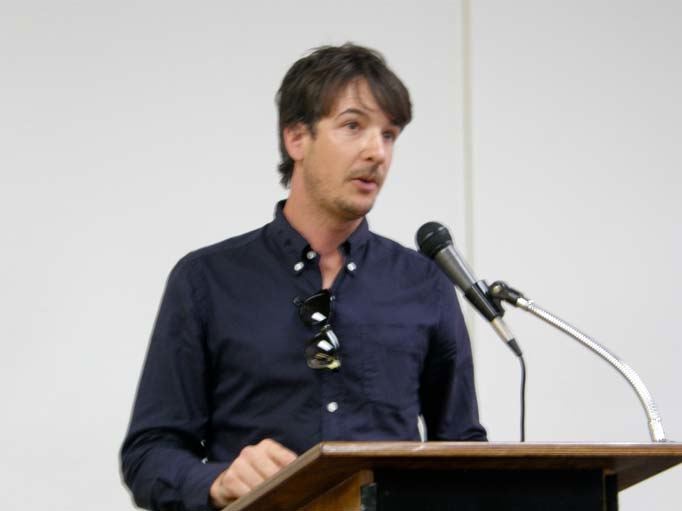 2007 Riverbench Vineyard & Winery Mesa Pinot Noir 14.3% alc., pH 3.71, 459 cases, $48. Riverbench Vineyard in the Santa Maria Valley has been supplying many wineries with world-class Pinot Noir and Chardonnay for 30 years. Originally planted in 1973, the vineyard was bought by a group of local families in 2004 who launched their own wine label under the Riverbench Winery label. Chuck Ortman, of Meridian fame, who sourced Riverbench fruit for many of his own wines over the years, has been the consulting winemaker since 2006. The winery’s tasting room is housed in a newly restored 1920s craftsman style home on the historic Foxen Canyon Wine Trail. This wine is sourced from a special section of the Riverbench vineyard that is called “The Mesa.” Darkly fruited and smoothly textured, this is an impressive wine that has the typical Santa Maria Valley earthiness, pepper and sinewy tannins. 2007 Shandel’s Oppenlander Comptche Mendocino County Pinot Noir 14.5% alc., <400 cases, $40. This vineyard is owned and farmed by fifth generation owners Bill and Norm Shandel. Winemaker John Pepe (below at the Grand Tasting) crafts the wine.This is a special vineyard that delivers a unique drinking experience. The intense purple fruits are exotic and persist forever on the fruit-filled finish. An excellent cellar candidate.
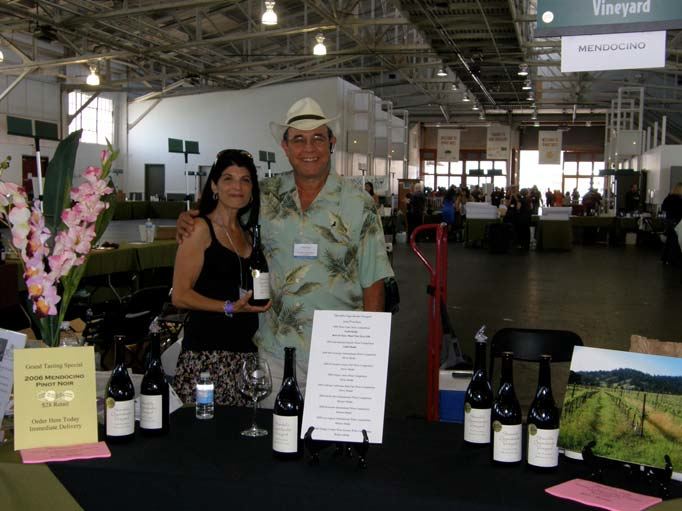 2008 Thomas George Estates Lancel Creek Vineyard Russian River Valley Pinot Noir 14.6% alc., <100 cases, $50. This vineyard is managed by Ulises Valdez. Pommard and Dijon 777 clones. Aged in 30% new French oak barrels. This is a very impressive wine that makes a statement. The theme is cherries and lots of them. Rich and potent, but not jammy, with great scent and a rich, spicy and tenacious palate. Tasted again at a Focus Tasting the next day and still found this wine to be striking. Also worth a look: 2008 Thomas George Estates Russian River Valley Pinot Noir ($38). 2007 WesMar Hellenthal Vineyard Sonoma Coast Pinot Noir 14.5% alc., 262 cases, $50. Unfined and unfiltered. Wines from this vineyard typically need time to evolve and this one is no exception. When tasted upon release in 2009, I found the wine brooding, but it now really sings. The lovely aromatics so typical of WesMar Pinot Noirs are in full blossom in this wine. The dense and deep, dark mixed berry fruits are enrobed in sturdy but soft tannins, the mid palate attack is memorable, and the generous finish sails along. 2008 Willowbrook Kaufman Sunnyslope Vineyard Sonoma Mountain Pinot Noir 14.5% alc., 130 cases, $34. Vineyard farmed by Greg Bjornstad. Planted to clones 23 and Dijon 777. Beautifully composed with appealing flavors of red fruits, spice box and savory herbs that play off each other in a highly nuanced performance. Also worth a look: 2008 Willowbrook Sonoma County Pinot Noir and 2008 Willowbrook Silver Pines Vineyard Sonoma Mountain Pinot Noir. 2008 Zepaltas La Cruz Vineyard Sonoma Coast Pinot Noir 14.2% alc., pH 3.70, 147 cases, $47. Petaluma Gap vineyard (Keller Estate). Clones 115, 114 and a mystery clone. Aged 11 months in 40% new French oak barrels. The biggest, richest Pinot Noir in the Zepaltas lineup this vintage but not at all over the top. Red and black fruits, nicely spiced with a touch of red licorice and loamy undertones. 2008 Zepaltas Suacci Vineyard Sonoma Coast Pinot Noir 13.7% alc., pH 3.60, 96 cases, $45. From a cold, windy and low-yielding vineyard southwest of Sebastopol. Aged 17 months in 40% new French oak barrels. Delicious red fruit with an herbal bent carries the theme in this elegant wine that is still tight.
Focus Tastings
Saturday, June 26, 2010
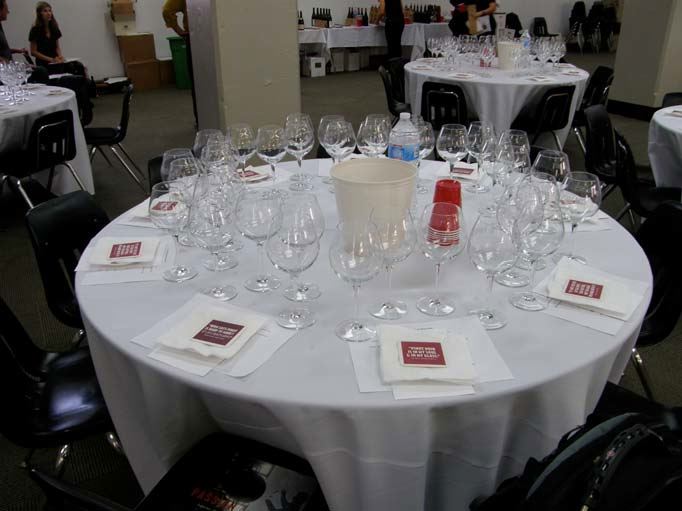 2008 Buena Vista Carneros Ramal Vineyard Estate Vineyard Series Carneros Pinot Noir 2,500 cases, $42. A plethora of sweet and juicy black cherries and dark berries with undertones of spice and earth. Winemaker Jeff Stewart (photo below) has taken this winery to new heights and the wines are superb.
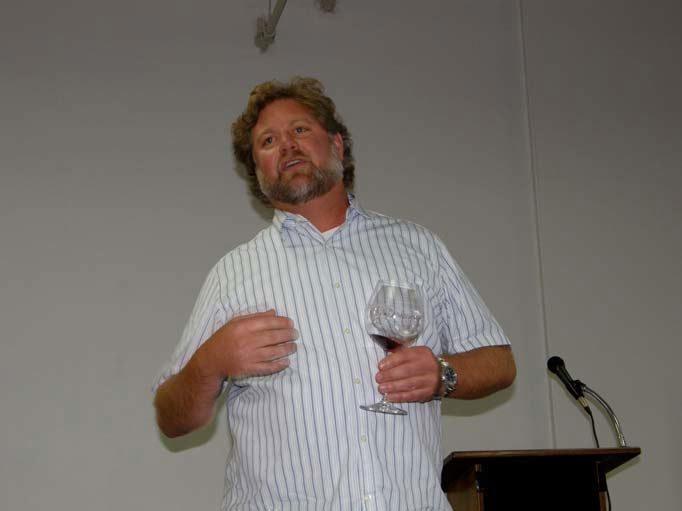 2008 C. Donatiello Floodgate Block 15 Russian River Valley Pinot Noir 14.2% alc., 400 cases, $48. 12 year-old vines, Dijon 667. Aged 10 months in 35% new French oak barrels. Owner Chris Donatiello (photo below) presented the wine. The goal here is to produce a food-friendly wine and that objective has definitely been met. Complex aromatic profile of ripe red cherries and berries, underbrush and Herbs de Provence. Soft in the mouth with notable flavors of cherries, cranberries and pomegranates. Elegantly styled and beautifully balanced. See other C. Donatiello 2008 wine reviews on page 27.
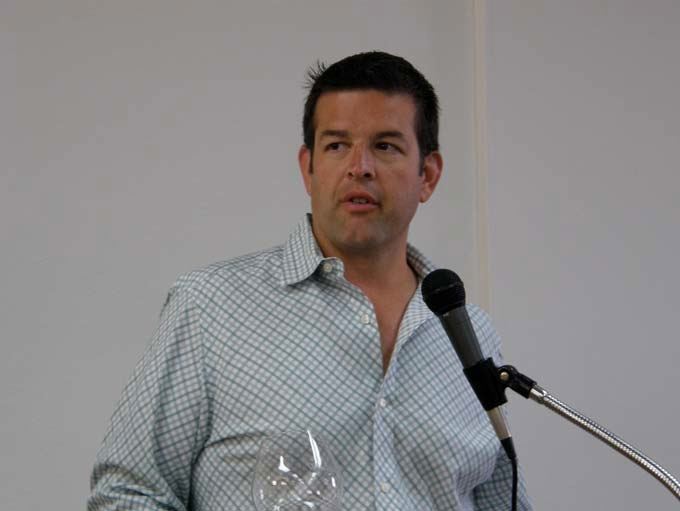 2008 Clos Pepe Clos Pepe Vineyard Vigneron Select Sta. Rita Hills Pinot Noir After a disastrous 2008 vintage marked by the loss of 75% of the crop at Clos Pepe Vineyard, this wine was a surprise to vintner Wes Hagen (photo below). A wine club member item. A delicate wine that exudes pinotosity. Lovely dark red fruits are featured accented with notes of cola and spice. A refreshing spark of mineral-imbibed acidity brings the demure fruit into focus. A gift that was salvaged from an almost hopeless situation.
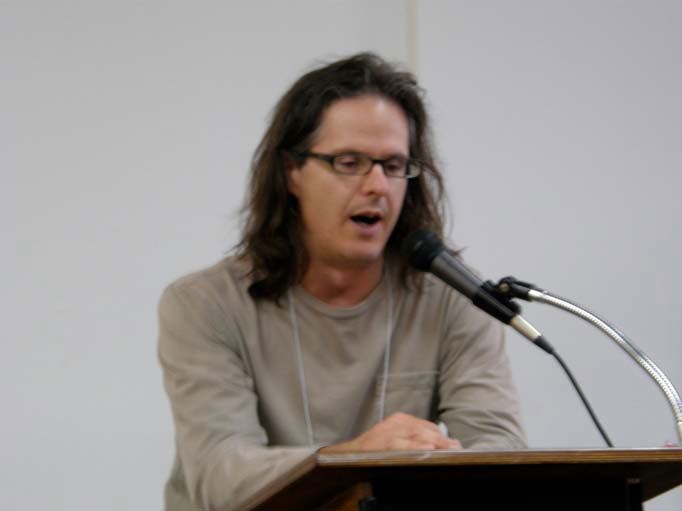 2008 Hug Cellars Rancho Ontiveros Vineyard Santa Maria Valley Pinot Noir 14.2% alc.. Fall release. Augie Hug (photo below) crafts distinctive small-lot vineyard-designated Central Coast Pinot Noirs as well as a number of other red varietals from his winery in Paso Robles. Wädenswil clones (1A: a clone developed by Mondavi at Byron that was never introduced for commercial use, and 2A). Native yeast fermentation. 100% whole cluster. Aged in 75% new French oak barrels. A bigger-styled fruity and earthy wine that gets better and better over time in the glass exhibiting attractive dark fruit driven aromas and a well spiced mouthful of luscious fruit. A subtle note of savory herbs hints at the whole cluster influence. Very smooth and pleasing in the mouth.
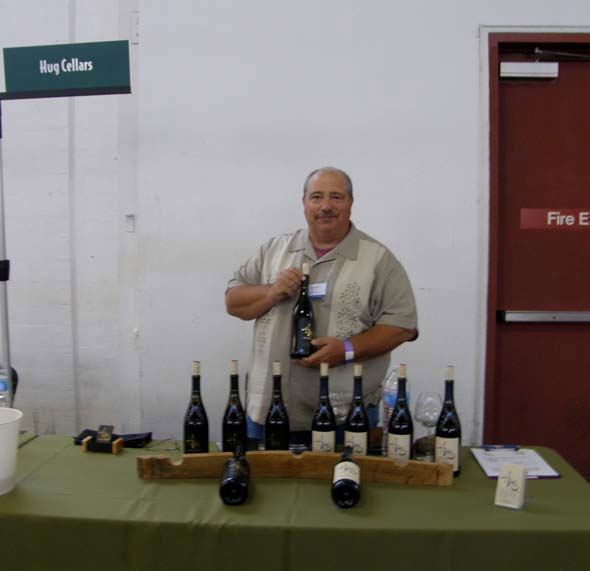 2008 Kosta Browne Koplen Vineyard Russian River Valley Pinot Noir Easy to pick out Michael Browne’s style in a blind tasting. Richly layered with hedonistic black cherry fruit that is mouth coating and persistent. Nicely spiced and very smooth in the mouth. 2008 La Fenêtre Le Bon Climat Vineyard Santa Maria Valley Pinot Noir 14.0% alc., $34 (futures price until 7/15). Joshau Klapper (photo below), a former Wine Director at Sona Restaurant in Los Angeles, learned the trade by working harvests at Au Bon Climat and Qupé while mentoring under Jim Clendenen, Bob Lindquist and Jim Adelman. He crafts multiple varietals including vineyard-designated Pinot Noirs from notable Central Coast vineyards. A Pinot that will sing at the table featuring spicy red fruits, savory herbs, delicate tannins, and bright acidity.
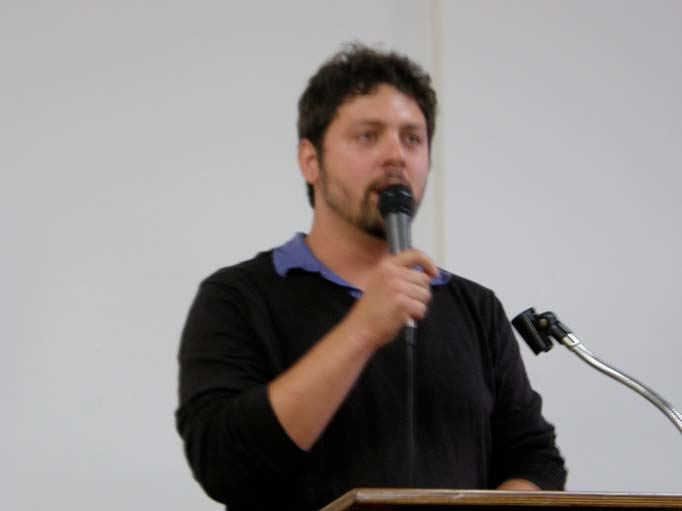 2008 Landmark Vineyards Saltonstall Vineyard Sonoma Coast Pinot Noir Unreleased. This vineyard is located in the Petaluma Gap and this wine represents the first harvest from this vineyard. Veteran Eric Stern and Greg Stach are the winemakers. Darkly fruited and well spiced with hints of caramel and cola, this is a charming wine with admirable balance. Very accessible now. 2008 Landy Family Vineyards Estate Russian River Valley Pinot Noir 175 cases, $46. Debut wine from this new winery owned by Jim (photo below) and Christina Landy. The estate vineyard was planted in 2001 to Syrah and Cabernet and budded over to Pinot Noir (Pommard and Calera clones) in 2007. The vineyard is one of the northernmost plantings in the Russian River Valley. Impressive first effort featuring ripe and lush dark fruits, a soft and sensual mouth feel and impeccable balance.
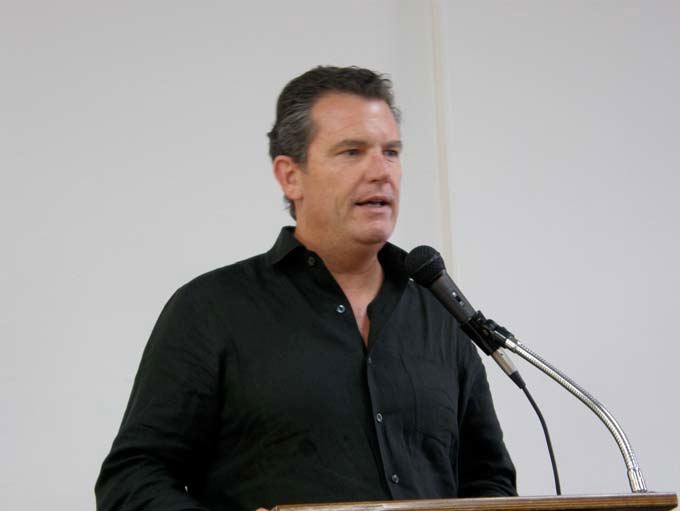 2008 MacMurray Ranch Winemaker’s Block Selection Russian River Valley Pinot Noir $60. This is the best Pinot Noir in the Gallo portfolio and one of the best kept secrets in the Pinot world. Aussie Susan Doyle (photo below) crafts this outstanding wine. This is a serious Pinot Noir that needs time in the glass to show its charms. I was just getting into it when the glass was whisked away for the next flight. A soft and juicy core of black cherries and mixed berries is very tasty and takes on more intensity over time.
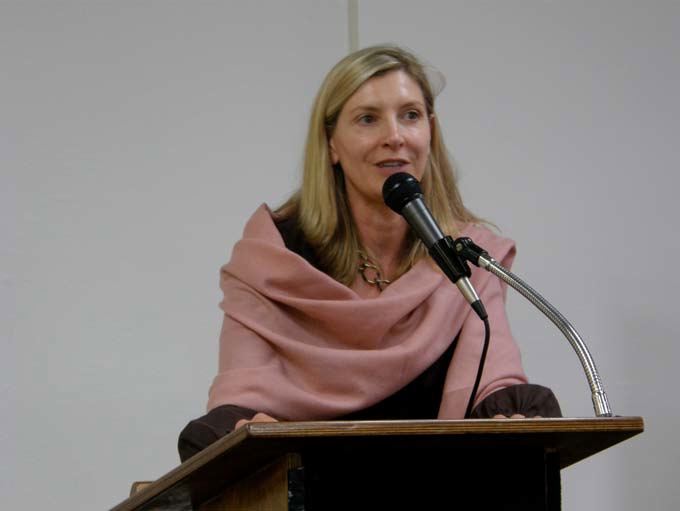 2008 Merry Edwards Winery Coopersmith Vineyard Russian River Valley Pinot Noir $57. This estate vineyard was originally planted in 2001 to UCD 37 clone (Mt. Eden) and Dijon 828. The 828 was too vigorous on this site and was all grafted over to UCD 37. The vineyard sits in the Laguna Ridge region of the Russian River Valley on the site of the Merry Edwards winery. This is a very interesting wine that stands out from the crowd undoubtedly due to is unique clonal origin. Bing cherries, baking spices, and cola are featured. Lively acidity and soft ripe tannins make for reasonable accessibility now. 2008 Native9 Rancho Ontiveros Vineyard Santa Maria Valley Pinot Noir 100% whole cluster. James Ontiveros owns and farms the Rancho Ontiveros Vineyard, selling some of the fruit to other producers and holding back some for his own label. Production is quite small and the wine has become somewhat of a cult favorite. The aromatics are shy at this point but the wine delivers a serious mouthful of red and black fruits backed by spicy, savory and earthy notes. Would have liked to spend more time with this young wine which is showing a hint of green herbs from the whole cluster which I suspect will integrate over time. Joe Davis tells me that the Burgundians who use significant whole cluster such as Dujac and DRC find that the stem qualities dissipate over time with extended barrel and bottle aging. 2008 Pelerin Wines Rosella’s Vineyard Santa Lucia Highlands Pinot Noir Unreleased. Chris (photo below) and Cathy Weidermann specialize in artisan wines from the Santa Lucia Highlands appellation. The pair have forged relationships with growers Gary Franscioni and Rich and Claudia Smith of Pariaso Vineyards, insuring access to very high quality grapes. This wine was aged 16 months in French oak barrels. Very delicately styled for a Santa Lucia Highlands Pinot Noir. Exudes grace and delicacy, offering delicious dark red fruits perfectly matched to ripe tannins and acidity. I was very taken by this wine.
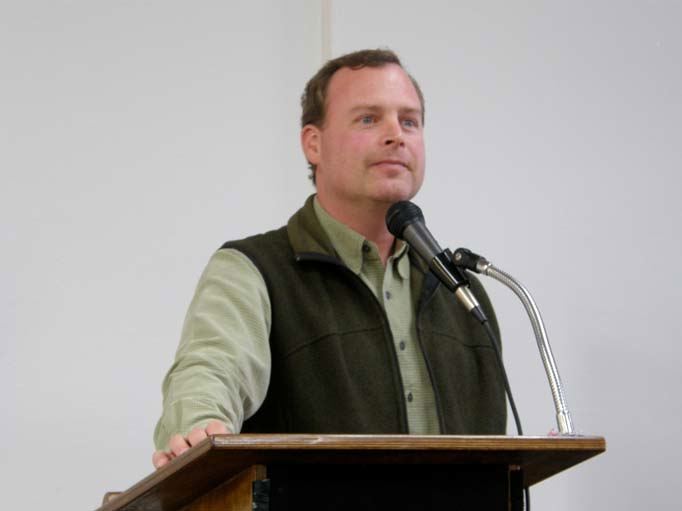 2008 Pisoni Vineyard & Winery Lucia Garys’ Vineyard Santa Lucia Highlands Pinot Noir The Garys’ Vineyard is owned and farmed by Gary Pisoni and Gary Franscioni. Lucia is a sister label to Pisoni Estate. Jeff Pisoni (photo below) is the winemaker for both labels. Thick, earthy and robust with a rich core of dark fruit infused with underpinnings of sweet oak, earth and mushrooms. Typical of the Pisoni style and easy to blindly pick out in this lineup of wines.
 2008 Sojourn Cellars Sangiacomo Vineyard Sonoma Coast Pinot Noir 14.5% alc., 580 cases, $48. This wine was reviewed very favorably in a recent issue of the PinotFile. It was nice to pick it out in a series of wines presented blind as one of my top picks. From Dijon clones planted in 1998. The vineyard is located just below Gap’s Crown Vineyard. Aged in 50% new French oak barrels. A perfectly composed and immensely satisfying wine with aromas and flavors of cherries and berries, nicely spiced and layered. Elegantly styled with a very appealing smooth mouth feel. Terrific. 2008 Tantara Winery Lindsay’s Vineyard Sta. Rita Hills Pinot Noir Unreleased. Jeff Fink (photo below) and Bill Cates craft Pinot Noir and Chardonnay from multiple top notch vineyards primarily within Santa Barbara County. Clone 777. Still young and tight, but showing tremendous potential. The nose is reluctant but on the palate the wine offers an extremely charming cherry fruit core with suede-like tannins and a caressing fruit-filled finish. Also worth a look: 2008 Tantara Winery Evelyn’s Pinot Noir.
 2008 Willamette Valley Vineyards “Whole Cluster” Willamette Valley Pinot Noir 12.5% alc., $20. Pommard, Wädenswil, Dijon 114, 115 and 667 clones. Crafted with carbonic maceration in the Beaujolais style. No oak exposure. Winemaker Forrest Klaffke (photo below) refers to this wine as “Pinot Noir on training wheels.” A fun wine that is fruit forward and casual. Bright red fruit flavors with an underlying tone of spice and sandalwood with a vivid cherry finish.
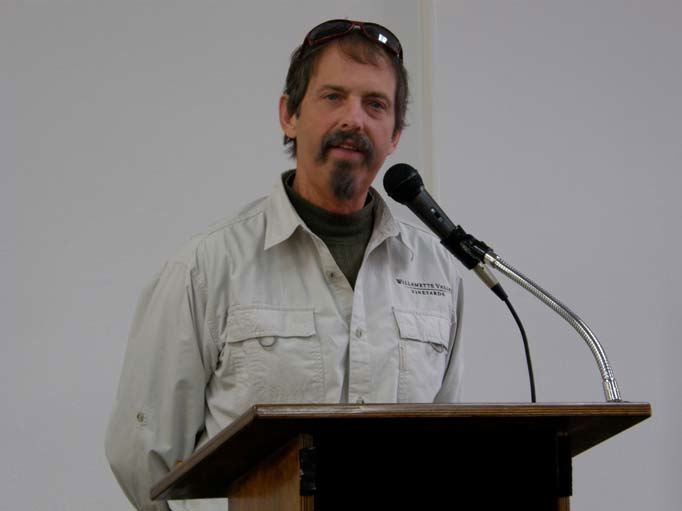
Grand TastingJune 27, 2010 There were several new faces at this year’s Pinot Days Grand Tasting, undaunted by the economy and the challenges of selling high-end Pinot Noir. I found several of them to be making very credible, if not very impressive wines. The new hounds in the race included: Ancient Oak Cellars (Santa Rosa), Ca’Momi Wines (Napa), Caraccioli Cellars (Gonzales), Cartograph (Healdsburg), Claypool Cellars (Santa Rosa), Coleman Nicole Wines (Roseville), Contessa de Carneros (Napa), Desmond Wines (Windsor), Expression Pinot Noir (Napa), Furthermore Wines (San Francisco), Inception Wines (Buellton), JCB by Jean-Charles Boisset (St. Helena), Joseph Jewell Wines (Windsor), La Fenêtre (Palos Verdes), Ladd Cellars (Oakland), (Landy Family Vineyards (Healdsburg), Longplay Wine (Newberg, OR), M. Autumn Wines (Portland, OR), Mercy Vineyards (Pebble Beach), Paradise View Wines (Sonoma), Perception Wines (Calistoga), Peter Paul Wines (San Rafael), R. Merlo Estate Wines (Redding), Ray Franscioni Wines (Salinas), S. Morris Wines (San Luis Obispo), Senders Wines (El Macero), Thirty-Seven (Sonoma), Tuck Beckstoffer Wines (St. Helena), Wrath (Soledad), Zotovich Family Vineyards (Newport Beach). Short descriptions of these producers can be found in my Home Page Wine Directory at www.princeofpinot.com.
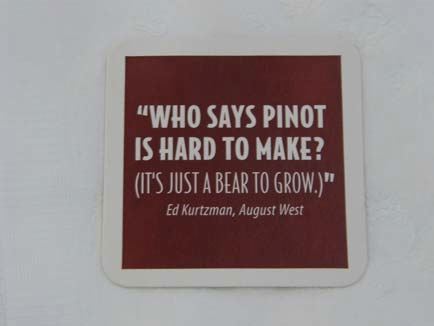 Desmond Estate Vineyards Bill and Dannette Robbins (photo below) began producing an estate Russian River Valley Pinot Noir with the 2007 vintage. The pair are quite passionate about Pinot Noir (Bill sold his Harley to buy a tractor for his vineyard) and the wines reflect their commitment. I reviewed the2008 Desmond Estate Vineyards Russian River Valley Pinot Noir very favorably in the June 8, 2010 issue of the PinotFile (www.princeofpinot.com/article/908/). The 2007 Desmond Estate Vineyards Russian River Valley Pinot Noir is reviewed in this issue in the “Small Sips of Pinot” feature.
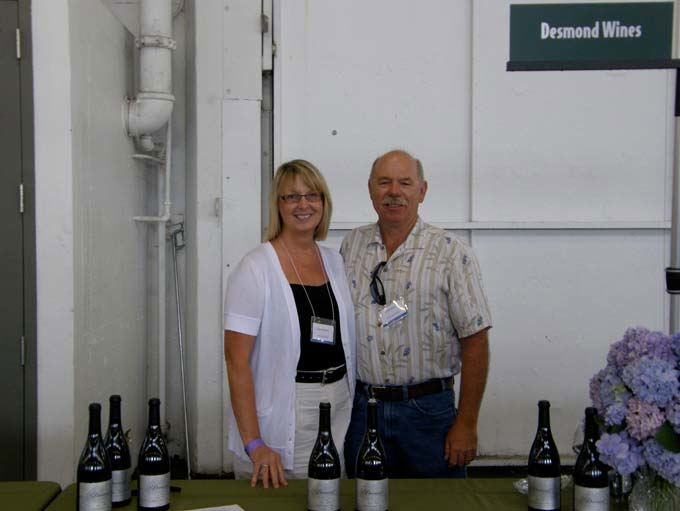 Eric Kent Wine Cellars As some of you know who read the PinotFile regularly, I have followed the wines of Kent Humphrey from the first vintage several years ago and have seen the style of the wines evolve. Kent now crafts Pinot Noir, Chardonnay and Syrah that are snapped up by his faithful followers and his booth was one of the busiest at this year’s Grand Tasting (preventing me from getting a photo). Kent’s Pinot Noirs have become more nuanced with less alcohol, less showy with better acidity, a more appealing mouthfeel, and brighter aromatics. The 2008 Eric Kent Freestone Small Town Sonoma Coast Pinot Noir (14.3% alc., 100 cases, $48, sold out) is a pretty wine that is well-structured but still far too tight for drinking. The 2008 Eric Kent Stiling Vineyard Russian River Valley Pinot Noir (14.7% alc.) is a November release that has a crunchy core of bright red fruits and hi-tone acidity. The 2009 Eric Kent Sascha’s Pinot Noir was a barrel sample of a blend of three vineyards that was flat-out delicious with mesmerizing fruit and a lively grip of acidity. The 2009 Eric Kent Freestone Small Town Sonoma Coast Pinot Noir (13.3% alc.) was a barrel sample. This vintage had some Petaluma Gap fruit included. 25% whole cluster. Showing plenty of character, sinewy tannins and a generous, spicy finish. Each bottle of Eric Kent wine shows off a different piece of artwork giving the wines added intrigue. A 2008 Eric Kent Russian River Valley Pinot Noir (14.6% alc., 350 cases, $36) is available in the marketplace. Wine Club members receive significant discounts on wines.
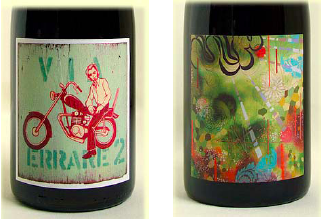 Furthermore Wines An urban winery in San Francisco formed by two partners specializing in small lots of premium Pinot Noir. The 2007 Furthermore Bohemian Vineyard Russian River Valley Pinot Noir (14.3% alc., 50 cases) is a very impressive drink with savory berries all wrapped up in sinewy tannins. The 2008 Furthermore Bohemian Vineyard Russian River Valley Pinot Noir is equally impressive. The 2008 Furthermore Amber Ridge Vineyard Russian River Valley Pinot Noir (14.3% alc., 75 cases) is quintessential Russian River Pinot with vivid Bing cherry fruit and spice. A Pinot Noir from Rosella’s Vineyard in the Santa Lucia Highlands will be available from the 2009 vintage. The very enthusiastic owners offer their wines online ($39.95). Hanzell Vineyards This iconic winery produces Pinot Noirs that are very age worthy. The 2000 Hanzell Vineyards Sonoma Valley Pinot Noir was generously poured out of magnum and it was fresh as a daisy, replete with fresh berry fruit and secondary notes of spice, leather and tea. Hartley Ostini Hitching Post WineryPartners Frank Ostini (photo below) and Gray Hartley were pouring some terrific wines. Since the founding of this label in 1984, production has steadily increased to over 15,000 cases. Production is now carried out at the new Terravant Winery in Buellton where tastings and sales of the Hitching Post wines are available. The 2008 Hitching Post Hometown Santa Barbara County Pinot Noir (14.1% alc., $20), is a blend of grapes from Bien Nacido Vineyard and Julia’s Vineyard. A solid daily drinker that is simple but pleasing and very soft in the mouth. The2007 Hitching Post St Rita’s Earth Santa Rita Hills Pinot Noir (14.5% alc.) is a stunner with a full load of luscious cherry and berry fruit crafted in a charming fashion. The 2007 Hitching Post Highliner Santa Barbara County Pinot Noir (14.2% alc.) is the top-of-theline blend of grapes from Bien Nacido Vineyard and Fiddlestix Vineyard. This is a very serious, highly structured wine, tightly wound and a candidate for the cellar. The winery offers an excellent Merlot as well, an almost humorous play on the famous denigration of Merlot in the movie Sideways that was filmed in part at the Hitching Post 2 Restaurant. Ostini and Hartley never take themselves or their wines too seriously as shown by their tee shirt (see below) that was hanging behind their booth with a double entendre name of “Perfect Set.”
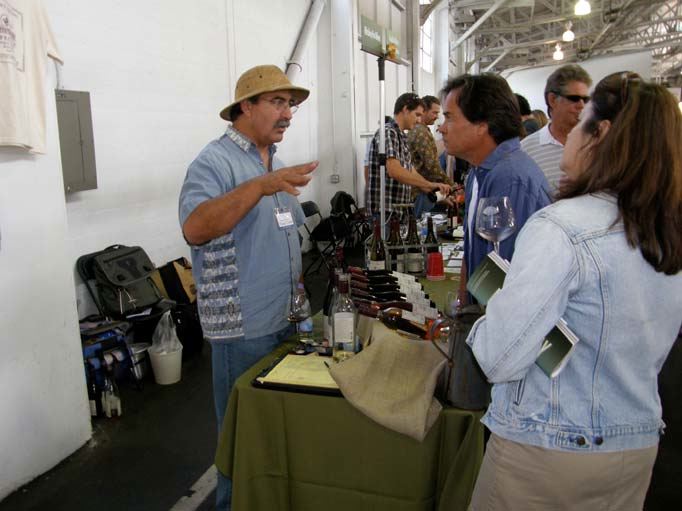
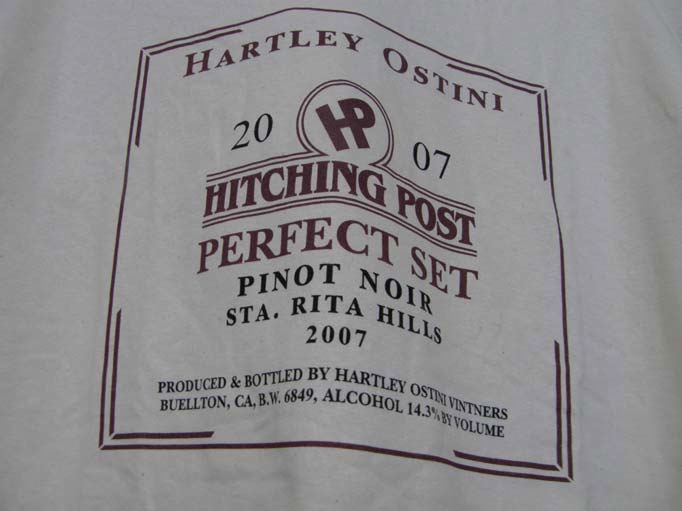 Le Cadeau Vineyard and Aubichon Known as the rockiest vineyard in Oregon, Tom and Deb Mortimer farm this 14-acre vineyard near Newberg, Oregon and produce four different 2008 Le Cadeau Pinot Noirs vinified by different winemakers to give a different expression of the vineyard. These wines have not been released. A second label, Aubichon, was added in the 2007 vintage. Vinified by winemaker Jim Sanders who trained under Mike Etzel at Beaux Freres, this Pinot Noir is not made from estate fruit but is sourced from vineyards managed by the same viticulturist who oversees the Le Cadeau Vineyard. The 2008 Le Cadeaux Rocheaux Willamette Valley Pinot Noir (13.9% alc.) is from the rockiest side of the vineyard and is vinified by Jacqueline Yoakum. Pommard and Dijon 777 clones. The wine is red fruited with grippy tannins and still very tight. The 2008 Le Cadeaux Côte Estate Willamette Valley Pinot Noir (13.5% alc.) is from chalky soil and was vinified by winemaker Steve Ryan. Primarily clone 667 with some 114 and 115. Flamboyant nose with luscious fruit, soft tannins and a very smooth texture. Approachable now. The 2008 Le Cadeaux Equinoxe Willamette Valley Pinot Noir (14.1% alc.) is from the central crest of the vineyard. Vinified by Jim Sanders. Discreetly concentrated red fruits with bright acidity. The 2007 Le Cadeau Equinoxe Willamette Valley Pinot Noir (13.5% alc, 450 cases) is primarily Dijon clones and was vinified by Jim Sanders. 25% whole cluster. This is a very complex and intensely flavored wine that is unusually rich for the 2007 vintage in Oregon. An impressive effort. The 2008 Le Cadeau Diversité Willamette Valley Pinot Noir (14.1% alc.) is from varied sections of the vineyard. Vinified by Scott Schull of Raptor Ridge. The only unfiltered wine, it offers ripe fruit, noticeable oak influence and a dry finish. Still tight and needing time to shed its oak and tannins. This project is very unique and the wines are worth your interest. Saxon Brown Wines I have been a fan of veteran winemaker Jeff Gaffner’s wines for many years. His production is tiny (less than 500 cases total) and sold almost entirely through a mailing list, but the wines are definitely worth searching out. The two 2007 vintage Pinot Noirs he was pouring were among the top wines I tasted at this event and the two 2008 vintage Pinot Noirs (fall release) are equally promising. Gaffner ages his wines in bottle for an additional year before release. The 2007 Saxon Brown Parmelee Hill Vineyard Sonoma Coast Pinot Noir (14.5% alc., 240 cases, $42), has the whole package with an alluring nose and tasty flavors of well-spiced fresh berries ending with a fruit-driven aromatic finish. The Saxon Brown Durrell Vineyard Hayfield Block Sonoma Valley Pinot Noir (14.5% alc., 240 cases, $45) is more savory and intense with remarkable purity of fruit and a very generous, lingering finish. The 2008 Saxon Brown Parmelee Hill Vineyard Sonoma Coast Pinot Noir exhibits intense purple fruits with more structure than its 2007 cousin. Still tight and unyielding. The 2008 Saxon Brown Durrell Vineyard Hayfield Block Sonoma Valley Pinot Noir is more refined than the 2007 version with less tannin and a little more upfront charm. Gaffner crafts a sparkling lineup of wines that includes Syrah, Zinfandel and even two different Semillons. This is a winery that definitely deserves your attention. Senders Wines Craig Senders, M.D. and his spouse, Karen, are proud owners of a small boutique winery specializing in small lots of Cabernet Sauvignon and Pinot Noir. Craig, who is a noted facial plastic surgeon and Professor at University of California at Davis specializing in children with facial birth defects, donates profits from the sales of his wines to the many “Giving Back” programs he participates in. See his impressive resume and activities at www.senderswines.com. Craig is a self-taught winemaker who found success and many awards for his home crafted wines and finally launched his commercial label with the 2006 vintage. I learned of his accomplishments in almost disbelief. He practices medicine full time, participates in many humanitarian programs, and manages to make outstanding wine as well. I was able to formally review two of the Senders wines (2007 Senders Wines Carneros Pinot Noir and 2007 Senders Wines Reserve Carneros Pinot Noir) at home after the Pinot Days event and the reviews are in this issue under the “Small Sips of Pinot” section. Skewis Wines Veteran winemaker Hank Skewis continues to offer complex and age worthy Pinot Noirs. I always stop by his booth at events to sample his latest and past wines. The 2007 Skewis Wines Peters Vineyard Sonoma Coast Pinot Noir (14.5% alc., $48) is made from 100% clone 777. Delicious core of fresh berry fruits and an amazingly sensual mouth feel. Skewis wines are sold exclusively through a mailing list. Sojourn Cellars I have been very impressed of late with the wines from this Pinot Noir specialist. Winemaker Erich Bradley has a remarkable touch with Pinot Noir and all of this winery’s offerings are first rate. I wrote a recent feature on this winery (www.princeofpinot.com/article/884/). I tasted three 2008 Pinot Noirs from Sojourn Cellars that were not reviewed in this article and they were very solid wines, albeit not quite up to the Sonoma Coast, Sangiacomo and Gap’s Crown wines I reviewed in that article: 2008 Sojourn Cellars Roger’s Creek Sonoma Coast Pinot Noir, 2008 Sojourn Cellars Windsor Oaks Pinot Noir, and 2008 Sojourn Cellars Russian River Valley Pinot Noir. I had a laugh over this last wine. Co-owner Craig Haserot told me the Wine Spectator gave the Russian River Valley blend Pinot Noir a score of 82. I found the wine quite pleasing with copious bright Bing cherry fruit and a seamless structure and certainly deserving of a much higher score. Three Sticks Winery Bill Price, proprietor of the famous Durrell Vineyard, selects the finest blocks of Pinot Noir from this 125-acre vineyard to produce Three Sticks Pinot Noir. Winemaker Tracey Bledsoe (photo below) along with consulting winemaker Don Van Staaveren is bringing this newer label to the forefront. The 2007 Three Sticks Winery Durrell Vineyard Sonoma Coast Pinot Noiris a winner, recently reviewed in the PinotFile (www.princeofpinot.com/article/908/) and recommended as a “charmer that flaunts Pinot’s sensual side.”
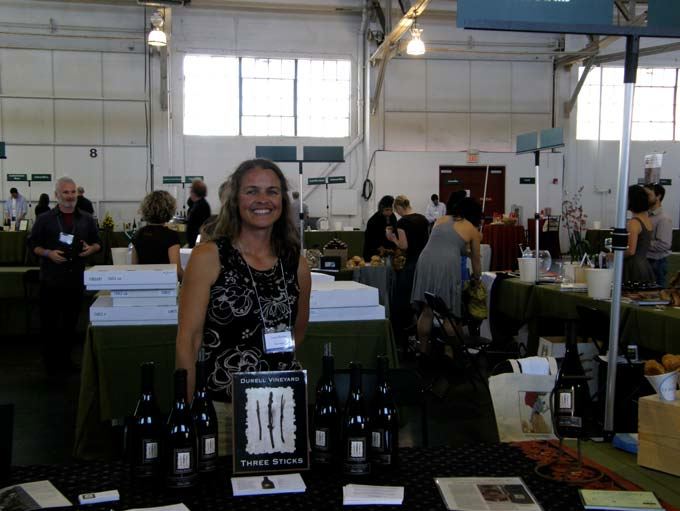 Weibel Family Vineyards & Winery The Weibel Family are California icons in the wine business, having produced California still and sparkling wines through four generations since 1939. They are best known for “Green Hungarian” wine. This is not a name that pinotphiles would ordinarily look to for Pinot Noir, but they produce a very good value-priced Pinot Noir from their H&W Estate Vineyard in Mendocino County. The 2006 Weibel Family Estate Pinot Noir (14.9% alc., pH 3.49, $17) is a very good daily drinker with bright cherry fruit and lively acidity to complement food. Westwood Winery This winery dates to 1984 when it was founded in the Sierra Foothills by Bert Urch and Betty Stoltz. Accomplished winemaker John Kelly and partners bought the winery in 2002 when it was moved to Sonoma Valley. Westwood has produced a Haynes Vineyard Pinot Noir continuously from 1985 to 2005, pulled from the same 1.5 acres located on the eastern side of the Napa Valley near Coombsville. The history of the Haynes Vineyard (now torn out) is complex and detailed on the Westwood Winery website (www.westwoodwine.com). Westwood’s Annadel Estate Vineyard, planted in 2007-2009, consists of 13 acres of Pinot Noir, with 1.5 acres devoted to the Haynes Vineyard Martini selection. The Westwood wines I tasted were a revelation and like no other California Pinot Noir. The 2003 Westwood Winery Haynes Vineyard Napa Valley Pinot Noir (173 cases, $60) and the 2005 Westwood Winery Haynes Vineyard Napa Valley Pinot Noir (174 cases, $45) are very unique wines. They are not fruit-driven like so many California Pinot Noirs, but have developed charming bouquets and secondary flavors that make aged Pinot Noir so alluring. The 2003 wine still has plenty of tannin for the long haul and undoubtedly will age another 20 years. The 2005 Westwood Winery Sonoma Valley Pinot Noir (266 cases, $45) is a blend of Dijon clone fruit from Nicholson Ranch Vineyard, Los Carneros and Annadel Estate Vineyard. This is a solid wine with every component singing in harmony marked by spicy aromas, an earthy undertone, and firm tannins offset by bright acidity. The 2007 Westwood Winery Annadel Estate Vineyard Pinot Noir (unreleased) is a sterling wine of great promise with appealing aromatics, a soft texture, and a structured backbone for aging. Kelly has quietly developed an impressive lineup of wines that offer the Pinot Noir enthusiast something different to explore. Highly recommended. The wines are sold on the website (www.westwoodwine.com) and offered for tasting at a unique Tasting Salon in downtown Sonoma (appointment suggested - phone 707-294-8278 or 707-480-2251). Kelly writes an excellent blog as well (www.winemakersnotesblog.com).
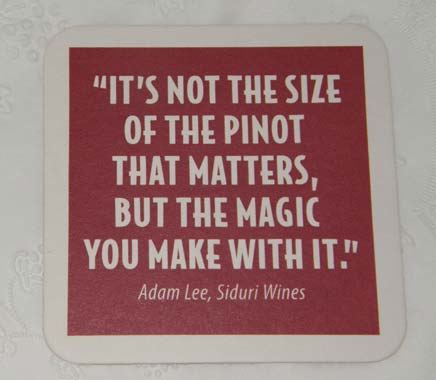 Willowbrook Cellars Winemaker Joe Otos has teamed with John Tracy of Owl Ridge Wine Services to produce a line of outstanding Pinot Noirs using grapes sourced from small vineyards in Sonoma and Marin counties (see also page 5 in this issue). Joe was beaming about the 2008 Willowbrook Chileno Valley Marin County Pinot Noir (14.4% alc., $34, unreleased). The two previous vintages were labeled Marin County, so this is the first vineyard-designated Pinot Noir by Willowbrook from this site. A very cohesive and brightly fashioned wine with enticing aromatics, vivid and nicely spiced red cherry fruit, and a refreshing grip of acidity on the finish. A very special wine at a great price. Windward Vineyard Owners Marc Goldberg and Maggie D’Ambrosia farm 25 acres of Pinot Noir near Templeton in the Paso Robles appellation. Goldberg’s reverence for Burgundy has led him to style his wines in an Old World fashion and his label proudly displays the word “monopole.” The owners have been at it since 1990 and that says something in today’s fast changing world. The 2006 Windward Vineyard Estate Paso Robles Pinot Noir (13.2%, $38) is a disarmingly charming wine. Delicately colored and composed, it offers a pure Pinot Noir drinking experience unencumbered by over extraction, high alcohol and oak. A rarity in today’s Pinot Noir market, but a wine Pinot Noir connoisseurs will relish. Visit the winery for tasting. Windy Oaks Estate I was so busy talking with winemaker Jim Schultze, that I failed to take adequate tasting notes on the superb Windy Oaks Pinot Noirs I sampled. Windy Oaks Estate is situated in Corralitos, in the southernmost tip of the Santa Cruz Mountains. The Schultzes farm, produce and bottle their Pinot Noirs in a small winery located in the center of the estate vineyard. The wines are clearly in the top echelon of California Pinot Noir producers. Jim is a fan of whole cluster (he wanted to steal my “got whole cluster?” hat) and the 2007 Windy Oaks Estate Whole Cluster Santa Cruz Mountains Pinot Noir ($55) shows why. Aged 21 months in 50% new French oak. Great in every way with a spicy fruit core and a creamy texture to tantalize. The 2007 Windy Oaks Estate Reserve Santa Cruz Mountains Pinot Noir (384 cases, $60) is from a superb vintage and represents some of the best barrels in the cellar. Primarily original vineyard plantings. Aged 23 months in 75% new French oak. Full of discreetly concentrated spiced cherry fruit, this is a wine of power, yet style and grace. Jim crafts a number of different Pinot Noirs include a wood tank fermented wine, a 100% wild yeast fermented wine, and an estate Pinot Noir from Henry’s Block composed of 100% Wädenswil clone. Understandably, 85% of the Windy Oaks production is sold through a faithful following on the mailing list. This is a producer that I personally buy wine from regularly for my cellar.
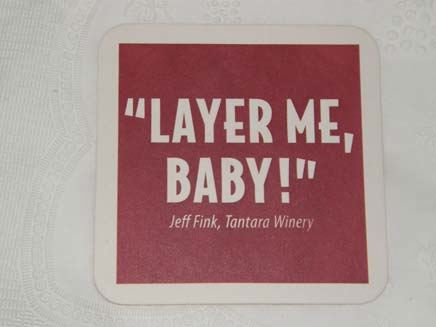
Resurgence at Foppiano VineyardsFoppiano Vineyards is one of Sonoma County’s oldest family owned wineries and represents an authentic family tradition marked by strength and perseverance dating back to 1896 (bonded winery 312). It is one of the few in California viticulture that can boast that they are six generations old. See page 21 for the winery’s historic timeline. Recently, the family has become dedicated to a renewed commitment to quality in their vineyards and wine program. Louis J. Foppiano Sr., a Russian River Valley pioneering winegrower has lived his entire life on the Foppiano ranch located at the northern edge of the Russian River Valley in Healdsburg. Now 100 years old, he was lovingly known to locals as “Louie” or “Lou, Sr.” He always crafted honest wines and became well known especially for Petite Sirah. He was more a farmer than a vintner and was famed for his legendary thriftiness. His winery facility had declined in recent years and locals called it “an old dump.” As the winery patriarch, Louis Foppiano Sr. was old school and resisted change at the winery. Two years ago, at the age of 98, the family took his driving keys away, and they have managed to keep him out of the winery where new equipment has been installed, and out of the vineyards where new viticulture techniques have been instituted. Louis Foppiano Jr., who has a marvelous sense of humor, told me, “We had to keep my father away from the vineyards so he wouldn’t see us dropping fruit. With the latest generation, including General Manager Louis M. Foppiano Jr. and vineyardist Paul Foppiano leading the charge, and with the addition of talented winemaker Natalie West and the management skills of President Todd Arterburn, Foppiano Vineyards has now made remarkable strides toward modernization while still maintaining a thriving tradition.
Petite Sirah was first brought to America from France in 1884. The father grape is Syrah and the mother grape is Peloursin, a humble grape from southern France. Since cross-regional breeding of grapes was frowned on in France, Petite Sirah was not accepted there, and found a new home in the United States, where, along with Zinfandel, has become America's own variety. Petite Sirah has survived phylloxera in the 1890s, both World Wars, the Depression, and Prohibition (during which time Petite Sirah was a main ingredient in sacramental wines). Concannon Vineyard was the first California winery to label the varietal Petite Sirah on the bottle in 1964. Over 90% of the California plantings labeled Petite Sirah may be Durif (or “Duriff”)grapes, named after Francois Durif, a botanist at the University of Montpellier, who first propagated it in the 1880s in the Rhone Valley. Durif and Petite Sirah are considered interchangeable synonyms referring to the same grape. Current DNA research at University of California at Davis indicates there are at least three different varieties that go by the name of Petite Sirah. One may be Durif, but two of them definitely are not. Petite Sirah is sometimes mistakenly spelled “Petite Syrah,” which historically was used by Rhone growers to refer to the small berries of the some of their Syrah grapevines. Syrah is not related to Petite Sirah. In California, immigrant vine growers introduced Syrah in 1978 and used the phrase “Petite Syrah” to refer to the lower yields that the vines then were producing in California. Old timers called Petite Sirah “Petty Sarah.” The height of Petite Sirah's popularity was in 1978 when more than 14,000 acres were planted. Today, there are less than 3,000 acres with most vines very old and some vines well over 80 years old. The flavor profile of Petite Sirah is similar to Syrah but the wine is not as elegant. Typically Petite Sirah is darkly colored, inky and tannic, with a peppery note and can be very long-lived. Foppiano Vineyards has been a tireless promoter of Petite Sirah and is a founder of P.S. I Love You, Inc, the advocacy group for Petite Sirah. Paul Foppiano joined the family business in 1998 and has gradually taking over the vineyard management duties. As we walked the vineyards, he explained that farming Pinot Noir at this particular site close to the Russian River was particularly challenging because of the threat of Pierce’s Disease. This warmer site of 150 plantable acres is far enough north to allow Petite Sirah and Zinfandel to thrive, but the proximity to the Russian River allows cooler weather varieties such as Pinot Noir and Chardonnay to grow in some areas as well The temperatures near the river where the Pinot Noir and Chardonnay are grown are as much as ten degrees lower than in the bench lands where the Petite Sirah is planted. Because of the intense heat during the summer, careful leaf pulling is delicately employed on the morning side only to prevent the Pinot Noir grapes from sunburn. The vines are cane pruned to allow to encourage added foliage to protect the grapes from the summer heat. A cover crop program has been instituted to improve the nitrogen in the soils, reduce tillage and erosion, and eliminate the need for added fertilizers. Owl boxes in the vineyard and falcon perches have helped to reduce the rodent population.
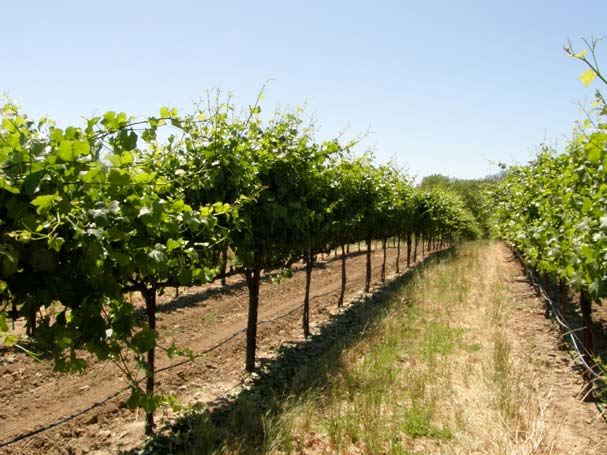 There are 30 acres of Pinot Noir in vines, with 10 acres planted only four years ago and not currently a part of the winery’s Pinot Noir program. The newly developed acreage is planted to Pommard 4 and 5 clones. Other clones in the vineyard include 2A and Dijon 113, 115, 667 and 777. The winery has acquired new sorting equipment to allow then to properly sort grapes in the vineyard and in the winery. Night harvesting has been instituted. A new press and de-stemmer are state-of-the-art, and new open top fermentors are part of the new commitment, as well as a new French oak barrel program and improved hygiene in the winery’s interior. Rather than rebuild the winery structures, the insides are undergoing a complete upgrade. The principals (pictured below from left to right are Louis Foppiano Jr., Natalie West, Paul Foppiano, and Todd Arterburn) are quite proud of the resurgence at Foppiano Vineyards and rightly so.
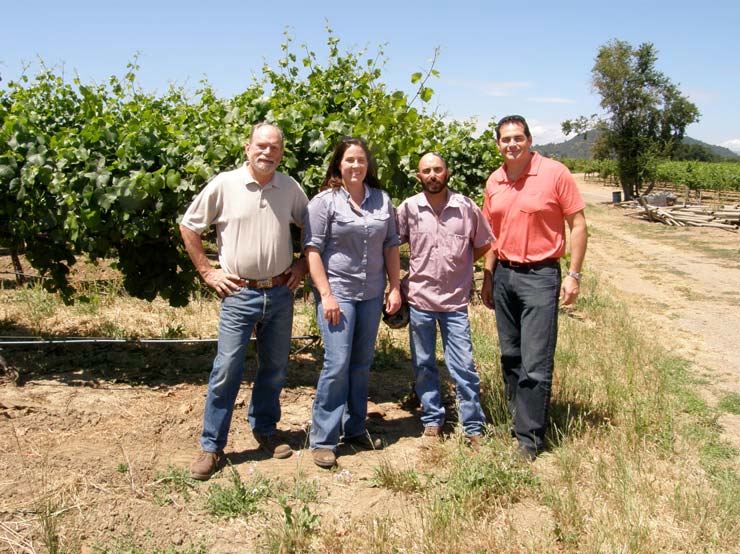 The Foppianos planted Pinot Noir in the 1970s but the grapes were put into their red wine blends. A separate Pinot Noir bottling was started in 2002 but there were quality problems with the wines. In June, 2008, Natalie West was hired as winemaker and this has been a perfect fit for the Foppiano Winery family. Natalie grew up in Healdsburg on a small vineyard in the Dry Creek Valley and attended Healdsburg High School. Her parents farmed old vine Zinfandel and Petite Sirah, and while growing up, she helped with the typical vineyard jobs such as suckering the vines, pruning, picking up pruning brush, and picking fruit. By the time she left for college, she had had enough of vineyard work and had no interest in the wine business at all. She attended University of California at Davis where she studied biological sciences, intent on becoming a medical doctor. During her second year at Davis, her fond memories of the wine country resurfaced and she developed an interest in the Viticulture and Enology Program at Davis. After the second year of college, Natalie worked harvest at Peterson Winery in Dry Creek Valley and found her calling. She returned to Davis, enrolled in the Viticulture and Enology Program and never looked back. After her schooling, Natalie worked as an intern at Clos LaChance Winery in San Martin and then spent time in New Zealand at Montana Wines (Brancott). Returning to California in time for the 2004 harvest, she worked as a lab technician for a year at J Vineyards & Winery before becoming an assistant winemaker at Ferrari-Carano. She feels that her childhood on a vineyard has given her a better appreciation of the life cycle of the vines and an understanding of the seasons and climate in the Russian River Valley. At Foppiano Vineyards, Natalie crafts several varietals including Petite Sirah and Zinfandel, her favorites, and Pinot Noir, Carignane, Cabernet Sauvignon, Chardonnay and Sauvignon Blanc.
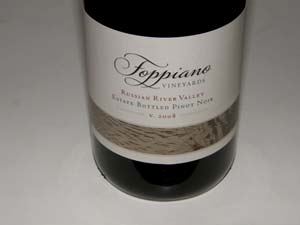 2008 Foppiano Vineyards Estate Russian River Valley Pinot Noir 14.9% alc., pH 3.77, 800 cases, $25. The grapes were de-stemmed and fermented in five ton open top fermentation tanks. Cold soak lasted 5 days. Aged 14 months in 30% new and 70% neutral French oak barrels. · Lovely scent of Bing cherries, strawberries, baking spices and sandalwood. On the palate, finesse is emphasized over fruit heaviness. Bright and tasty red cherry and ripe strawberry fruit flavors have a subtle confected tone with hints of red licorice and vanilla. The alcohol gives the wine a welcoming richness and is perfectly integrated. Gossamer tannins create an Elvis on velvet texture. Still drank fine the next day from an opened and re-corked bottle. An impressive example of a warmer weather Pinot that hits all the high notes at the right price.
Foppiano Vineyards wines are available for sampling at the winery’s tasting room which is filled with historic photos and wine memorabilia. The tasting room is at 12707 Old Redwood Highway in Healdsburg. The wines are also available online at www.foppiano.com. Foppiano is one of the few wineries that welcomes visitors to roam through the estate vineyard unattended. A vineyard tour brochure is offered, giving the visitor a guide to the different grape varieties planted on the ranch. No pretensions or facade here. As a node to the winery’s renaissance, a completely new logo, label and packaging is offered on the newest releases which is very classy.
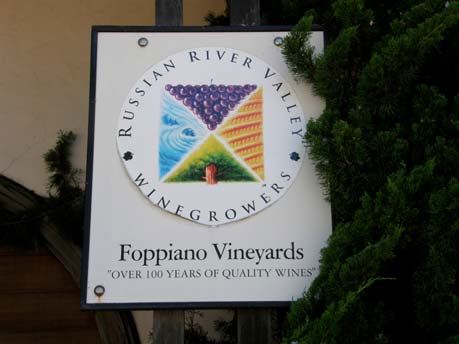
Historic Timeline of Foppiano Vineyards
1864Giovanni settled in Healdsburg. 1896 Giovanni bought a working winery, “Riverside Farm,” where Foppiano Vineyards now stands and operates today. He founded Foppiano Wine Company and developed a market for his wines. 1910 Louis A. Foppiano bought the winery from his father and built Foppiano Vineyards into one of the area’s most successful wineries. At the time, everything south of the winery and north in Alexander Valley was planted to pears, prunes and apples. 1919 With the beginning of Prohibition, the market for wine disappeared. Foppiano Vineyards was kept in business farming fruit and grapes for home winemakers. 1924 Federal agents raided Foppiano Vineyards and forced Louis to dump over 100,000 gallons of the 1918 vintage into a creek in front of the winery. People came from miles around with cups and jars and drank from the creek. 1933 With the end of Prohibition, Louis J. Foppiano, at the age of 23, revived the winery. 1937 A new winery facility was built and Foppiano Vineyards became one of the first Sonoma wineries to bottle its own wines. Louis J. Foppiano was a one-man operation, functioning as President, Winemaker, Director of Marketing and Sales, and Vineyard Manager. He was a dog lover and always had Chihuahuas around. While he was working in the vineyards, they would crawl up his arm and sit on his shoulder. 1941 800,000 gallons of wine was produced annually. 1943 The current winery facility was built. During the war, lumbar was hard to come by, but Louis knew several people who worked in the nearby mills. 1945 The Sotoyome Vineyard adjacent the Foppiano property was bought by Louis. 1946 Louis J. Foppiano founded the Sonoma County Winegrowers Association (which later became the Sonoma County Wineries Association) and was involved in the founding of the California Wine Institute. He was the Director of the Institute for five years. 1960s Fruit trees on the property were removed and Cabernet Sauvignon was planted along with other varieties. Petite Sirah was retained. The business model moved to “premium” wine production. 1969 First vintage-dated bottling of Foppiano Vineyards varietal wines. 1970s-1990s Louis J. Foppiano’s sons Louis M. (Louis Jr.) and Rod joined the business, Louis M. as the Director of Sales & Marketing and Rod as winemaker. A daughter, Susan Foppiano-Valera, has been in charge of hospitality for many years. Two brands were added: Riverside Vineyards and Fox Mountain with Foppiano remaining the premium wine label. Transitioned to a 100% red wine brand. 1994 New Petite Sirah vineyard planted to meet increasing demands for the wine. 2008 Natalie West was hired as winemaker. 2009 COO Todd Arterburn and direct sales manager Darci Feigel joined the Foppiano team. Visit the Foppiano Vineyards’ website for a detailed chronology.
Gary Farrell Vineyards & Winery: Embracing the LegacySome consider Gary Farrell the father of Russian River Valley Pinot Noir because he was one of the first Pinot Noir winemakers to rise to prominence at the start of the Pinot Noir revolution in the region. Farrell, who had majored in political science at Sonoma State University, developed an interest in wine as a student, and decided after college to become a winemaker. He was largely self-taught, but developed added winemaking skills during the mid-1970s working in the cellars of Tom Dehlinger, Robert Stemmler and Davis Bynum. He developed a special friendship with Davis Bynum’s son, Hampton, and was hired as winemaker at Davis Bynum Winery in 1978. Farrell continued as winemaker at Davis Bynum Winery until 2000. Davis Bynum had built the first winery on Westside Road and produced Pinot Noir from Joe Rochioli, Jr.’s first crop. The 1973 Davis Bynum Winery Rochioli Vineyard Pinot Noir was the first Russian River designated wine, and along with Joesph Swan’s 1973 Pinot Noir, the first vineyard-designated Pinot Noir from what became the Russian River Valley appellation. From 1973 until 1981, Davis Bynum Winery was the only winery to receive Rochioli Vineyard grapes. Farrell started his own label in 1982, releasing a 50 case blend of Rochioli West Block and Allen Vineyard fruit. The wine sold for $80 a case and much of it was hand-delivered to local retailers and customers. The same year, Farrell made the inaugural Pinot Noir for Rochioli Vineyard and Winery, trading winemaking for grapes for his own inaugural release, and for a few years served as a consultant and assisted in the planning and construction of the Rochioli Winery. This close relationship continues to this day with Gary Farrell Vineyards & Winery receiving grapes annually from Rochioli Vineyard on a handshake basis much to the consternation of the current owners. I enjoyed a number of Farrell’s Pinot Noirs through the early years, but a 1987 Gary Farrell Russian River Valley Pinot Noir made an indelible impression on my wine psyche at a time when my passion for Pinot Noir was in its formative years. I still have the label from this wine.
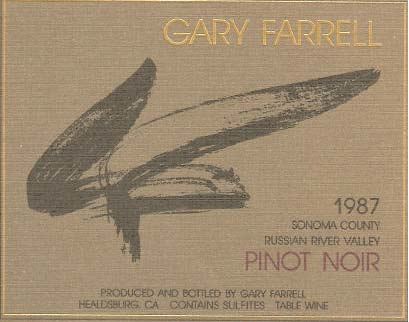 Farrell’s production of his own label increased to 11,000 cases by 1999 outgrowing the facility at Davis Bynum Winery. Along with financing assistance from noted wine business investor, Bill Hambrecht, a new architecturally stunning winery was built on Westside Road, still the home of Gary Farrell Vineyards & Winery. Farrell was to sell his eponymous label and Westside Road winery to Allied Domecq in 2004. Subsequently it was acquired by Beam Wine Estates and then sold to Ascentia Wine Estates, the current owners. Farrell had difficulty working under corporate ownership, reportedly feeling handcuffed by an inability to remain connected to all phases of winemaking. He left the Gary Farrell Winery in 2006 to return to his roots as a small artisan producer, partnering again with Bill Hambrecht to found a new label, Alysian Wines. Farrell chose Susan Reed, who had worked with him for four years, to succeed him as winemaker. Reed had her first winemaking exposure at Simi Winery in 1981, working under Zelma Long as a senior laboratory technician. In 1984, she assumed a similar position at Matanzas Creek Winery, and by 1989 had become the winemaker, working alongside cellar master Bill Parker. When Matanzas Creek was sold to Jess Jackson in 2001, she pursued other interests briefly, but was drawn back to winemaking. She sought out a position among the Westside Road winery community and landed a job at Gary Farrell in 2003, rising to Associate Winemaker in July 2004. She became the clear choice of Farrell to carry on his program when he departed. The winery has not missed a step as Reed has successfully maintained the high quality of the wines, adhered faithfully to the “Gary Farrell style,” and continued to embrace Farrell’s legacy of consistent excellence. A video of Susan Reed explaining her winemaking philosophy is available on the website.
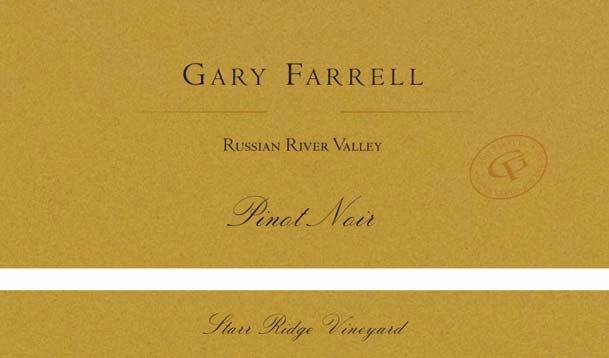 I visited Gary Farrell Vineyards & Winery recently, enjoying a tour of the well-equipped facility which has a simple but pleasing aesthetic, and sat down with winemaker Susan Reed to taste through the lineup of 2007 Chardonnays and Pinot Noirs and yet to be released 2008 Pinot Noirs. The wines are styled with elegance and balance, and often harvested a little earlier with resulting in moderate alcohols and bright acidity to insure food compatibility. The wines are fruity with soft tannins to allow early drinkability, although some bottlings such as the Starr Ridge Pinot Noir typically require some time in the bottle. All the wines were moderately colored unless otherwise noted. The Chardonnays all undergo 100% malolactic fermentation in barrel with lees stirring for 7 to 8 months in 33% to 55% new French oak. The Pinot Noirs receive a 5 to 10 day cold soak, are 100% de-stemmed, fermented in 4 to 5 ton fermenters to dryness with Assmanshausen yeast, generally lasting 8 to 14 days, and then usually aged 9 to 12 months in French oak barrels (Francois Freres, Rousseau and Sequin Moreau). The percentage of new oak varies with the vineyard source (Hallberg Vineyard 54%, Rochioli Vineyard 50%, Carneros 44%, and Russian River Valley 30%). The wines are racked carefully once during the barrel aging cycle. The appellation-designated selections are the winery’s focus and are widely distributed in the marketplace. The vineyard-designated wines are sold primarily to wine club members and through the tasting room. The 2008 appellation selection Chardonnays and Pinot Noirs will be released in September 2010 and the vineyard-designate series at the end of 2010. The wines are all solid and will not disappoint fans of more classically styled wines. The Rochioli Vineyard (some vintages bottled as Rochioli-Allen Vineyards) and Hallberg Pinot Noirs are clearly the class of what is a very stellar lineup.
2008 Gary Farrell Hallberg Vineyard Dijon Clones Russian River Valley Pinot Noir 100% clone 777. · Enticing aromas of plums, black cherries and underbrush. Very tasty core of dark red fruits that are nicely spiced. Still a Lolita and will need time to integrate the oak and shed some tannins, but the potential here is clearly all upside.
2008 Gary Farrell Rochioli Vineyard Russian River Valley Pinot Noir This wine makes you sit up and take notice of the legendary pedigree. Lovely dark red fruits, cola and spice wrapped in ripe, firm tannins and set off beautifully by balancing acidity. Not to the level of the 2007 bottling at this stage, but clearly another glass of class.
2008 Gary Farrell Russian River Valley Selection Russian River Valley Pinot Noir 14.2% alc., pH 3.47, 4,332 cases, $42. To be released September 2010. Aged 8 months in 30% new French oak. · Subdued aromas of red cherries, red licorice and oak vanillin. Welcoming richness of juicy dark red fruits with a spark of acidity on the refreshing finish. Good.
2008 Gary Farrell Carneros Selection Carneros Pinot Noir 14.2% alc., pH 3.50, 932 cases, $45. Released in April 2010. Sourced from six blocks of the Ramal Vineyard. Aged in 44% new French oak. · Subdued aromas of exotic dark fruits, herbs and violets. Delicious essence of black cherries with the fruit playing the lead role over earthiness. Soft and smooth in the mouth. Very good.
2007 Gary Farrell Carneros Selection Carneros Chardonnay 14.2% alc., pH 3.41, 780 cases, $36. Released in February 2009. Multiple clones from Ramal Vineyard in Carneros. Aged 7 months in 41% new French oak. · Shy on the nose but with pleasing flavors of poached pears, white peach and subtle oak spice with a steely acidity driving the mineral-toned finish. Good.
2007 Gary Farrell Russian River Selection Russian River Valley Chardonnay 14.2% alc., pH 3.32, 6,677 cases, $36. Released in February 2009. Multiple clones, primarily Russian River Valley fruit with some Carneros and Bien Nacido fruit. Barrel fermented and aged in 33% new French oak. · A clean, demure wine with aromas and flavors of lemon curd, tropical fruits and roasted nuts with a refreshing lift of acidity on the fruity finish. Good.
2007 Gary Farrell Rochioli-Allen Vineyards Russian River Valley Chardonnay 14.2% alc., pH 3.35, 472 cases, $41. Released November 1, 2009. Clone 5, 15, 12 and 8 from Rochioli Vineyard (43%) and clones 15 and 76 from Allen Vineyard (57%). Aged in 55% new French oak. · Needs some time in the glass to release its charms. Lovely scent of lemons, poached apples, and wet rocks leading to a relatively lush mouth feel and flavors of tropical fruits, orange peel, and green apples. A wine with serious intentions. Very good.
2007 Gary Farrell Carneros Selection Carneros Pinot Noir 14.4% alc., pH 3.46, 1,336 cases, $45. Released in April 2009. Sourced from ten blocks of the Ramal Vineyard. · Intensely dark fruited nose which is very enticing. Savory flavors of black cherries and dark berries with a subtle earth and mineral underpinning and mild but noticeable fine-grain tannins. Very typical of Carneros Pinot Noir. Good (+).
2007 Gary Farrell Cresta Ridge Vineyard Russian River Valley Chardonnay 14.3% alc., pH 3.27, 193 cases, $45. Released in June 2009. Cresta Ridge Vineyard is located in Sebastopol within the Green Valley- Russian River Valley appellation. Dijon clones 95 and 76. · Aromas of buttered popcorn, baked apples and oatmeal lead to discreetly rich flavors of lemon curd, bread stick and white stone fruits. Very impressive mineral-laden spine that brightens the finish and welcomes another sip. Very good.
2007 Gary Farrell Russian River Valley Selection Russian River Valley Pinot Noir 14.2% alc., pH 3.49, 12,045 cases, $45. Released in September 2009. Sourced from eight Russian River Valley vineyards as well as Ramal Vineyard in Carneros and Bien Nacido Vineyards in Santa Maria Valley. · The aromas really come at you with bright notes of Bing cherries, raspberries, cola, oak spice and Provencal herbs. Red-fruited and discreetly concentrated with soft tannins and ending in a short but lively cherry-laden finish. Good.
2007 Gary Farrell Hallberg Vineyard Russian River Valley Pinot Noir 14.2% alc., pH 3.43, 527 cases, $50. Released in November 2009. The 100-acre Hallberg Vineyard is named for previous owners Don and Marcia Hallberg and today is owned by investors headed by Brice Jones (Emeritus) and farmed by one owner, Kirk Lokka. 58% clone 777, 31% clone 667 and 11% Pommard clone. · Deep reddish-purple color in the glass. Aromas of crisp dark fruits, forest floor and woodshed. Intense and thick on the palate with hints of grilled meat, tea and tobacco accenting the luscious black cherry and blackberry core. Remarkable persistence on the finish which features a hint of citrus peel. As different from the Rochioli bottling as night and day, but equally fine.
2007 Gary Farrell Starr Ridge Vineyard Dijon Clones Russian River Valley Pinot Noir 14.1% alc., pH 3.50, 298 cases, $50. Released November 1, 2009. Dijon clones 114, 115 and 777 from the 24-acre Starr Ridge Vineyard located in the hills just east of the Russian River and southwest of the town of Windsor. · Terrific aromatics featuring an intense perfume of dark, red and black cherry and berry fruits. On the palate, the wine lags the showy aromas, offering a shy but similar fruit profile with notes of forest floor, seasoned oak and savory herbs. Needs more time to shed the oak and drying tannins. Good.
2007 Gary Farrell Hallberg Vineyard Dijon Clones Russian River Valley Pinot Noir 14.4% alc., pH 3.44, 303 cases, $60. Released in February 2010. 52% clone 777, 43% clone 667 and 4% Pommard. · Deep, dark reddish-purple color in the glass. Similar aroma profile to the Hallberg bottling with high notes of forest floor and woodshed, but with redder berry scents. More fruit charm and crisper on the palate, less earthy and showing less grilled fruit flavors. Noticeable ripe tannins, but very smooth in the mouth. Very good.
2007 Gary Farrell Rochioli Vineyard Russian River Valley Pinot Noir 14.2% alc., pH 3.43, 519 cases, $65. Released November 1, 2009. Sourced from a 13-acre block of Rochioli Vineyard that border the Russian River planted in 1995 and taken from cuttings of the original “mother” West Block planted in 1969. Pommard clone. · A stunning wine that hits all the high notes. Enticing and intensely perfumed nose of black cherries, spice and loamy earth. Delicious core of berry and currant flavors with a spectacular cherry-driven aromatic finish that lingers for what seems like a minute. Beautifully composed, with tannins, fruit and acidity singing in harmony along with a velvety mouth feel. Class in the glass.
The stylish tasting room at Gary Farrell Vineyards & Winery is open daily from 10:30 to 4:30. There are a number of tour and tasting options. The wines are also sold online at www.garyfarrellwines.com.
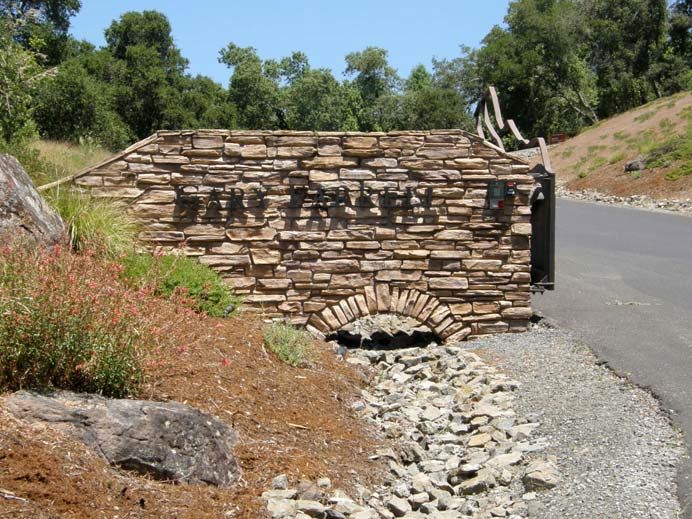
Tasting the 08s at C. Donatiello WineryI first reported on this relatively new winery along the Westside Road Middle Reach corridor shortly after it opened in June 2008. Focusing on small lot Pinot Noirs and Chardonnays from the estate vineyard and specially chose vineyards in the Russian River Valley, C. Donatiello made an auspicious debut and the quality of the wines has continued to elevate. Christopher Donatiello (photo below at Pinot Days), a former New York-based wine and spirits distributor, teamed with investment banker Bill Hambrecht to renovate and revitalize the site of the former Belvedere Winery in Healdsburg. The new spectacular 14.5-acre estate has an organically farmed Pinot Noir vineyard (Maddie’s), a contemporary wood and glass hospitality center and tasted room designed by noted winery architect and landscaper, Ken Munson, and an organic garden that introduces visitors to flora that have a natural affinity with the aromas found in the two Burgundian varieties. The winery facility onsite has been upgraded and outfitted with the latest in winemaking technology.
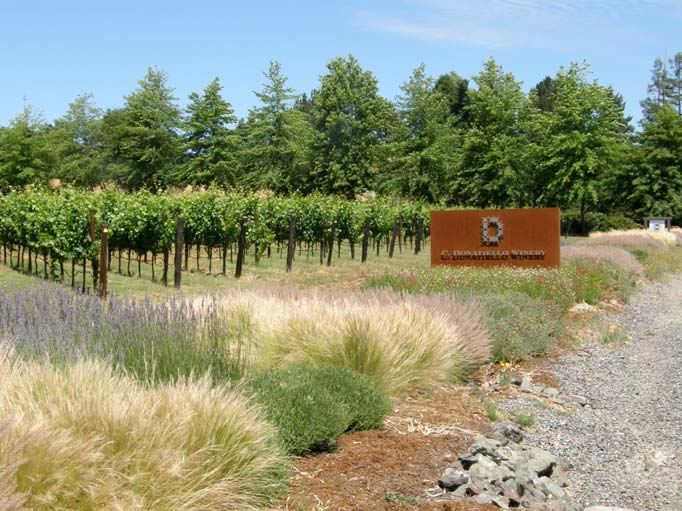 Winemaker Webster Marquez, who honed his skills at Williams Selyem and makes wine in partnership at Anthill Farms Winery, has brought the label to prominence. The focus at C. Donatiello is producing wines of stylish grace and classic elegance that perform well with food. I recently stopped in at C. Donatiello and sat down with both Chris and Webster to sample the lineup of C. Donatiello wines. Webster told me that the 2008 vintage was extremely challenging with the quality of the wines varying greatly from vineyard to vineyard. He laughed, “It was a vintage that separated the men from the boys.” There were 35 nights of frost in the Trenton area of the Russian River Valley and even vines that survived the extended frost had very uneven fruit set. A warm summer was highlighted by a ten day heat wave in August. Those that waited out the heat were fortunate as daily fog set in and picking was less hurried, the wines more successful. C. Donatiello’s Maddie’s Vineyard (photo above) suffered considerable frost damage and the entire crop from Hervey Vineyard was lost from frost. The 2009 vintage, in contrast, was “dreamy,” with a long, cool, perfect summer allowing harvest to evolve as expected. Despite the challenges, there were some very good, even special wines produced at C. Donatiello in 2008. These are not Caliesque blockbusters, but wines of restraint and nuance.
2008 Donatiello Russian River Valley Sauvignon Blanc 14.1% alc., 220 cases, $20. · A fine casual drink featuring tropical and tart lemon flavors accented with a very subtle grassy note. Crisp and bright. Good.
2008 C. Donatiello Middle Reach Russian River Valley Pinot Noir 14.2% alc., 86 cases, $28. To be offered to the winery’s wine club in the fall of 2010. Primarily sourced from Maddie’s Vineyard. Aged 10 months in 40% new French oak barrels. · Very shy aromas of crushed red strawberries and raspberries, leading to a medium weighted cherry and berry core which has some persistence on the fruity finish. Needs more time in the bottle. Good
2008 C. Donatiello Russian River Valley Pinot Noir 14.2% alc., 1,825 cases, $38. Sourced from four vineyards. Aged 10 months in 30% new French oak barrels. · Moderately light in color in the glass. The aromas pick up interest over time offering scents of red fruits, red candy, herbs, graham and cut flowers. Light on the palate, with bright acidity and a pleasing oak-kissed cherry lift on the finish. Good.
2008 C. Donatiello Floodgate Vineyard Block 15 Russian River Valley Pinot Noir 14.2% alc., 400 cases, $48. Clone 667 from 12 year old vines. Aged 10 months in 35% new French oak barrels. · The most flamboyant aromatics in the lineup offering a melange of bright red cherries and berries with a hint of spice, sawdust and fragrant flowers. Moderately intense and pleasingly soft in the mouth with red fruit flavors, enhanced by notes of red licorice and sweet oak. Like all the 2008 C. Donatiello Pinot Noirs, this wine has lively acidity. Very good.
2008 C. Donatiello Floodgate Vineyard Old Vines Russian River Valley Pinot Noir 13.7% alc., 115 cases, about $55 when released in October 2010. Martini clone. Aged 10 months in 35% new French oak barrels. · Moderate reddish-purple robe in the glass. The nose really draws your attention with intensely perfumed dark stone fruits and dark chocolate. Impressively harmonious in the mouth with dynamic dark red and black fruits, kissed by toasty oak, and wrapped in fine-grain tannins. A wine to contemplate for its uniqueness and striking flavor that only old vines can offer.
2008 C. Donatiello Maddie’s Vineyard Russian River Valley Pinot Noir 14.4% alc., 150 cases, $62. Aged 10 months in 35% new French oak barrels. · Light in color but nicely endowed with lovely delicate aromas of slightly confected red cherries, strawberries and cranberries. A discreetly rich and tasty Bing cherry essence is wrapped in gossamer tannins and focused by brisk acidity. A wine of elegant charm that typifies the C. Donatiello style. Very good.
2008 C. Donatiello Wind Horse Vineyard Russian River Valley Pinot Noir 14.2% alc., 45 cases, $72. This vineyard is located southwest of Sebastopol. Aged 10 months in 50% new French oak barrels. · A little more depth of color than the preceding wines. A riper fruit profile on the nose which is very expressive. Smoothly textured and moderately rich on the palate, this wine has a delicious array of dark red fruits including raspberries ending with a big flourish of fruit. There is a well-structured tannic backbone with a good grip of balancing acidity. This one can go the distance and will pick up charisma with more time in the bottle. Very good (+).
The C. Donatiello Winery tasting room is open daily from 11:00 AM to 5:00 PM at 4035 Westside Rd, Healdsburg. Private tours of the winery and the adjacent aroma garden and Wine and Cheese pairings are available by appointment (800-433-8296). The wines are available online at www.cdonatiello.com. C. Donatiello is now releasing a value-priced ($19) appellation series of wines labeled Healdsburg Ranches as well. For the third year, C. Donatiello Winery is hosting a summer season of “Live From the Middle Reach,” a series of Sunday afternoon concerts where bands perform at the winery overlooking the estate’s picturesque organic aroma garden and vineyard. A total of sixteen bands will be featured this summer between June 27 and October 10. Admission is free for all patrons of C. Donatiello Winery. Visit the winery’s website for a schedule and more details.
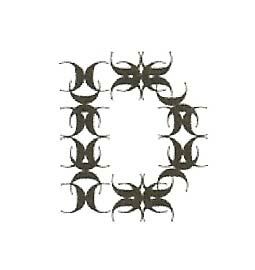
Churchill Cellars: A Piece of Pinot HeavenSuppose you love Pinot Noir, want to farm a small plot of land and live in the wine country. You could not do any better than follow the lead of Ken and Susan Churchill who sold their environmental consulting business in the East Bay, bought a prime vineyard property on Olivet Road in the Russian River Valley, and planted 2,000 small Pinot Noir vines on a 1-acre vineyard. They renovated and modernized the existing farmhouse, built a small tasting room and case storage area, put a pool in the ground, and set up a tennis court adjacent the vines. This little bit of wine country nirvana made me green with envy. Ken is a gentleman farmer who enjoys spending time in his Bella Luna Vineyard. Small Vines Viticulture (www.princeofpinot.com/winery/583/) installed the close-planted vineyard which is lovingly and sustainably farmed. The vineyard was possibly the first in the Russian River Valley planted with Dijon 459 clone. Other clones in the vineyard include Dijon 115, 667, and 777. The vineyard has quite a bit of diversity among the different clonal plantings and the variation in climate even within this small plot. Ken said that there can be a six degree temperature difference across the vineyard.
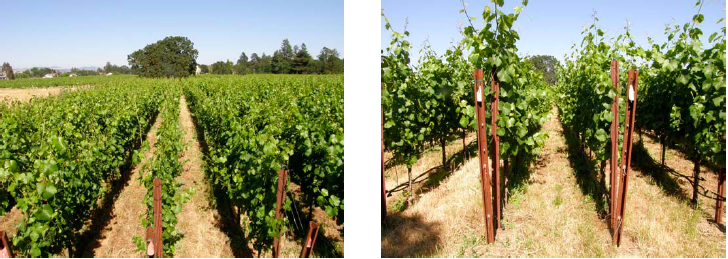 The winemaker is noted veteran Anthony Austin whose career spans over 35 vintages. A University of California at Davis graduate, Austin studied under the late great Andre Tchelistcheff. He made legendary Pinot Noirs in 1982 under his own label, Austin Cellars, from Sierra Madre Vineyard and Bien Nacido Vineyard fruit. Currently, he also makes wines for his own label (Left Edge Cellars) as well as Russian River Valley Vineyards, Sonoma Coast Vineyards and Cloud’s Rest. Production at Churchill Cellars is understandably small, varying with the vintage. The inaugural vintage was 2003, producing all of 46 cases. The Bella Luna Vineyard had its biggest crop of 275 cases in 2006, but frost damage in 2007 led to a smaller 120 case production. Additional fruit has been sourced in recent vintages for other vineyard-designate Pinot Noirs, bringing total production at Churchill Cellars to about 1,000 cases. In 2008, the output at Leepin Vineyard was taken over by Paul Sloan of Small Vines Wines and Churchill Cellars will not produce any Pinot Noir in the future from this source. All the Churchill Cellars Pinot Noirs are similar, a reflection of very similar Dijon clone composition.
2007 Churchill Cellars Bella Luna Vineyard Russian River Valley Pinot Noir 14.6% alc., pH 3.59, 120 cases, $45. Dijon clones 115, 459, 667 and 777. Aged 18 months in barrel. Released March 1, 2010. · Aromas of red and black cherries, balsam and menthol. Moderately rich mouthful of dark red stone fruits, an underlying savory note of herbal oak, healthy, ripe tannins and a big fruity finish. Plenty of fruit front and center, but not jammy and brought into focus with lively acidity. Good.
2007 Churchill Cellars Leepin Vineyard Sonoma Coast Pinot Noir 14.1% alc., pH 3.70, 214 cases, $45. Released March 1, 2010. Dijon clones 113, 115, 667 and 777. Aged 18 months in barrel. · Very shy fruit on the nose combined with scents of oak and charcoal. Dark cherry and berry core with an earthy underpinning, sandpaper tannins and a refreshing grip of acidity on the dry finish. Good.
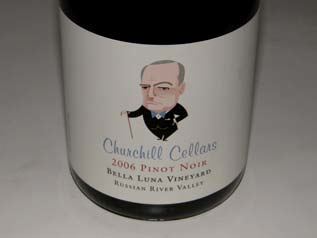 2006 Churchill Cellars Bella Luna Vineyard Russian River Valley Pinot Noir 14.95% alc. (labeled 14.5%), pH 3.56, 275 cases, $39. Aged 18 months in barrel. Dijon clones 115, 459, 667 and 777. Released September 1, 2008. · Moderately light garnet color. Bright perfume of strawberries, Bing cherries and underbrush which fades some over time in the glass with some heat showing up. Tasty flavors of red cherries and strawberries with soft tannins, an appealing lift of cherry fruit on the finish, and exemplary finesse. Good.
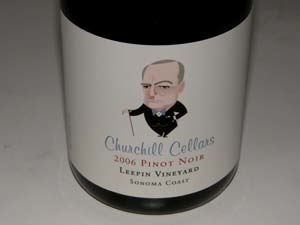 2006 Churchill Cellars Leepin Vineyard Sonoma Coast Pinot Noir 14.95% alc. (labeled 14.5%), pH 3.72, 300 cases, $39. Released September 1, 2008. Dijon clones 113, 115, 667 and 777. Aged 18 months in barrel. · Moderately light garnet color in the glass. Flashy scents of red berries, berry jam and oak spice. Lovely marriage of cherry and berry flavors on the palate with underpinnings of oak, savory herbs and earth tones. A solid wine with admirable elegance. Very good.
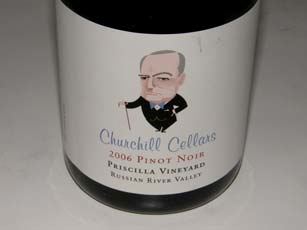 2006 Churchill Cellars Priscella Vineyard Russian River Valley Pinot Noir 14.6% alc., pH 3.65, 425 cases, $39. Dijon clones 114, 115, 667 and 777 from a sustainably farmed vineyard owned by Curt and Valerie Abbott. · The terrific nose draws you in with aromas of black cherries, dark red berries, seasoned oak and tea. Delicious red cherry and berry core with hints of sandalwood, toasty oak and cherry skins ending in a smooth finish with a complimentary grip of citric peel. A charming and easy drinking wine with the most mid palate richness of the three wines from this vintage. Very good.
Churchill Cellars Pinot Noir is available online at www.churchill-cellars.com. Wine Club members save 15%-25%.
Pali Wine Co.: Manages an Ambitiously Diverse PortfolioPali Wine Co. was founded in 2005 by a group of wine lovers headed by Tim Perr and Scott Knight in homage to Pacific Palisades in Southern California, the community where they live and work. The pair had developed relationships with many premium Pinot Noir growers on the West Coast and decided to develop their passion for Pinot Noir into a business. A modern winery was completed in Lompoc, California in time for the 2007 vintage and is the first building in Lompoc constructed specifically as a winery (photo below).
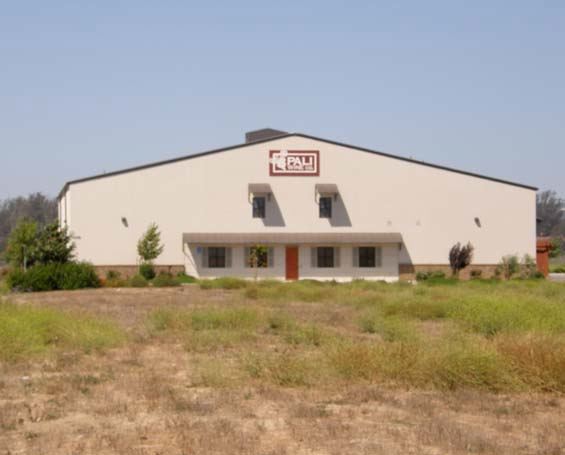 The winery specializes in single-vineyard bottlings of Pinot Noir, sourcing fruit from Oregon’s Willamette Valley, the Russian River Valley, Sonoma Coast, Central Coast and Sta. Rita Hills. This is the only California winery with a sizable Oregon footprint. With the 2007 vintage, several regional cuvées of Pinot Noir were released at a value price. Aaron Walker is the onsite winemaker with veteran Kenneth Juhasz (Auteur, Donum Estate, Robert Stemmler Wines) consulting. The 2008 vintage in California was challenging and the wines from this vintage have had their ups and downs. Admirably, Pali Wine Co. was able to manage the diverse source of grapes and turn out a stellar lineup of wines. These are generous fruit-driven wines with moderate to moderately high alcohols and generally easy accessibility upon release. All the vineyard-designated Pinot Noirs are scheduled for October 2010 release. A 2008 Shea Vineyard Chardonnay ($34) is also available.
2008 Pali Wine Co. Alphabets Willamette Valley Pinot Noir 14.0% alc., $18, screw cap. Aged 10 months in 50% new French oak barrels. · This is a ripe fruit styled Pinot Noir more typical of California than Oregon. Copious dark red cherries and berries kissed with oak in a simple fruity wine that is smooth in the mouth and finishes with a zing of acidity. Decent.
2008 Pali Wine Co. Riviera Sonoma Coast Pinot Noir 14.9% alc., $18, screw cap. · Aromas of alluring spiced dark berries with a hint of toasted oak. Moderately rich flavors of dark berries and plums with a touch of toasty oak and smoke. Decent.
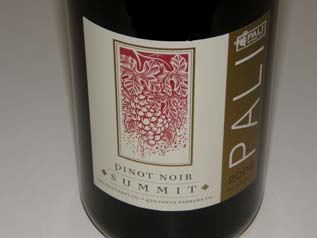 2008 Pali Wine Co. Summit Central Coast Pinot Noir 14.6% alc., 252 cases, $29, screw cap. Released in April 2010. 55% Monterey County fruit (Boer Vineyard in the Chalone AVA) and 45% Santa Barbara County fruit (Turner Vineyard). Aged 16 months in 50% French oak barrels. · This is an upfront wine with plenty of charisma. Very charming aromatics featuring black cherries and berries, spice, toasty oak, and cut flowers. The fruit is hi-tone and travels like a laser beam to the nose although the aromatic intensity fades a bit over time in the glass. On the palate there is a rich and satisfying core of black raspberry, blackberry, plum sauce, cola and grilled mushroom flavors with oak harmonizing in the background. A fruit lovers wine that will pair beautifully with hearty meats. This is a handy wine to buy by the case for everyday drinking. Very good.
2008 Pali Wine Co. Durell Vineyard Sonoma Coast Pinot Noir 15.4% alc., 175 cases, $44, screw cap. This vineyard was planted in 1979 by Ed Durell and his vineyard manager Steve Hill in the foothills of Sonoma Valley. The vineyard is now owned by Bill and Ellie Price but continues to be managed by Steve Hill and his son Ned. The 180 acres are planted primarily to Chardonnay and Pinot Noir. Clones 115, 667 and Pommard 5. Aged 16 months in 50% new French oak barrels. · Dark reddish-purple color in the glass. Aromatic black fruits with hints of toast and smoke. Generous core of sweet dark fruits with a hint of tar and ash on the finish. Rich and ripe, held in tune with svelte tannins, and finishing with an intensely fruity snap. Decent.
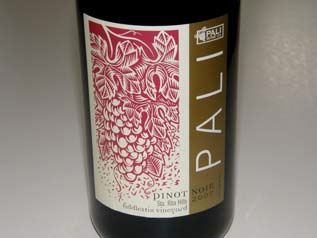 2008 Pali Wine Co. Fiddlestix Vineyard Sta. Rita Hills Pinot Noir 15.1% alc., 125 cases, $44, screw cap. Clones 667 and Pommard 4. Aged 16 months in 50% new French oak barrels. · Darkly colored in the glass. Wellscented nose featuring red and black fruits, spice and subtle oak. The flavors echo the aromas with an added touch of vanilla and citrus peel. The luscious fruit makes a statement on the palate, yet remains light on its feet. The chalky tannins are quite normal for this vineyard. The alcohol is well integrated and the fruit-laden finish lingers for some time. Very good (+).
2008 Pali Wine Co. Keefer Ranch Vineyard Russian River Valley Pinot Noir 14.5% alc., 225 cases, $44, screw cap. Clones 777 and Pommard 4. Aged 10 months in 33% new French oak barrels. · Enticing aromas of redder fruits including cherries and strawberries with accents of sandalwood and baking spices. Soft and smooth in the mouth, displaying a medium-weighted core of tasty red berries slipping off the back of the palate with a bright finish of admirable persistence. An exemplary wine that is typical of Pinot Noir from this venerated vineyard. Very good.
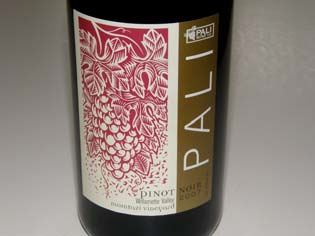 2008 Pali Wine Co. Momtazi Vineyard Willamette Valley Pinot Noir 14.1% alc., 150 cases, $44, screw cap. Clones 113, 114, 115 from this biodynamically farmed 200-acre vineyard. Aged 16 months in 40% new French oak barrels. · This is a charming wine with pleasing aromas of dark stone fruits and raspberries with an undertone of sweet oak. Ornate and well-delineated flavors of juicy cherries and berries with a subtle loamy undertow that is typical of the McMinnville appellation. Very slick with a soft texture much like a baby’s bottom. Everything sings in harmony with perfectly balanced t n‘ a. Still drank beautifully the next day from a previously opened and re-corked bottle indicating age ability.
2008 Pali Wine Co. Shea Vineyard Willamette Valley Pinot Noir 14.1% alc., 250 cases, $44, screw cap. Clones 114, 777 and Pommard. Aged 16 months in 40% new French oak barrels. · Moderately light reddish color. Interesting aromas of black cherries, truffles, lavender and brewed tea. Tight and restrained in the mouth yet some lovely spiced fruit lingers in the background enhanced with an appealing earthiness and meatiness. The fruit is enrobed in prodigious tannins. Hard to get close to at first but noticeably better the next day from a previously opened and re-corked bottle. A cellar candidate. Very good.
2008 Pali Wine Co. Zenith Vineyard Willamette Valley Pinot Noir 13.8% alc., 100 cases, $44, screw cap. Zenith Vineyard is owned and farmed by Tim and Kari Ramey and their partner, St. Innocent Ltd. The vineyard is planted to 60 acres of Pinot Noir, 12 acres of Chardonnay and 9 acres of Pinot Gris. Aged 10 months in 40% new French oak barrels. · Moderately light and reddish in color. Striking nose that is very floral highlighting red roses with a hint of oak and peppery spice. Did they put roses in the ferment? An easy drinking wine that is soft and smooth in the mouth featuring flavors of dark red strawberries, raspberries, and edible flowers. A little spice and earthiness adds interest. Fine-grain tannins and bright acidity in the background add to the allure. Good.
Tastings of Pali Wine Co. wines are available at the winery (1036 W. Aviation Drive, Lompoc) on Friday and Saturday from 11:00 to 4:00) and by appointment. The wines are sold primarily through a mailing list with some national retail distribution. Visit the website at www.paliwineco.com for more information.
Benziger: Proudly Devoted to Biodynamic WinegrowingYour next winery touring plans to Northern California should include the Benziger Family Winery, tucked inside an extinct volcanic caldera shaped like a bowl sitting in a valley 800 feet above sea level. Situated just outside the quaint town of Glen Ellen in Sonoma County, you will definitely enjoy the picturesque setting with majestic vineyards perched among the property’s diverse topography. However, it is the emphasis here on sustainable winegrowing, and in particular biodynamic farming, that will capture your interest.
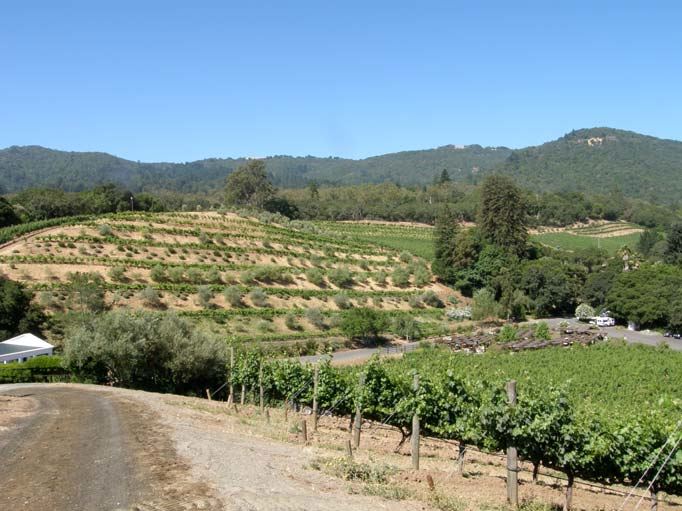 Every wine in the Benziger portfolio carries a third party certification of green farming practices, but it is the emphasis on biodynamics that sets Benziger apart from many wineries. All four of the estate vineyards are Demeter-certified Biodynamic, among the very few Demeter certified-Biodynamic vineyards in North America.
Rudolph Steiner had a far-reaching influence in many areas of philosophy, education and anthroposophical medicine. Among wine circles, he is most famous as the father of the theories of biodynamic agriculture. The basic tenant of biodynamic farming is the so-called self-contained “farm organism.” The farm is viewed as a self-nourishing organism and none or few outside materials are brought onto the farm. According to the Demeter organization (Biodynamic® is a registered trademark of the Demeter association of Biodynamic® farmers), “Biodynamic® agriculture views the farm as a self-contained, self-sustaining ecosystem responsible for creating and maintaining its individual health and vitality without any external or unnatural additions.” Replacement of nutrients is allowed and the use of compost is encouraged, with some restricted external sources of compost allowed. “Emphasis is placed on the integration of crops and livestock, recycling of nutrients, soil maintenance, and the health and well-being of the animals, the farmer, the farm, and the earth: all are integral parts that make up the whole.” The Demeter organization also recommends the use of nine preparations. “Preparations are utilized in field sprays and compost inoculants applied in minute doses.” Finally, Demeter recommends the use of the astronomical calendar “when planning activities such as pruning, cultivating, harvesting and spray preparations. Winegrowers who believe in Biodynamic® agriculture, use the astronomical calendar to determine when to harvest, when to bottle and when to engage in other wine processing decisions. There is no scientific way to prove or disprove whether Biodynamic® agriculture is valid because alternatives cannot be used in the Biodynamic® farm to make a scientific comparison. For more information, consult the website, www.biodynamics.com. or www.demeter-usa.org. When I recently visited Benziger Family Winery, I spent some time in the vineyards with winemaker Rodrigo Soto who works closely with Alan York. York is a recognized international expert on Biodynamic® farming. He came to Sonoma Mountain to collaborate with Mike Benziger in 1997, and has overseen Biodynamic farming on Benziger’s four certified Biodynamic vineyard estates ever since. Soto also brings extensive international winegrowing experience with Biodynamic and organic wineries. At Benziger, there is a self-guided Biodynamic® Discovery Trail that gives the visitor all the scoop. Below are photos of the Trail Tour, the compost and compost tea that are an integral part of Biodynamic farming.
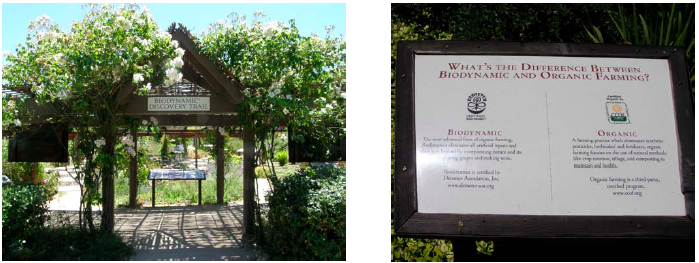
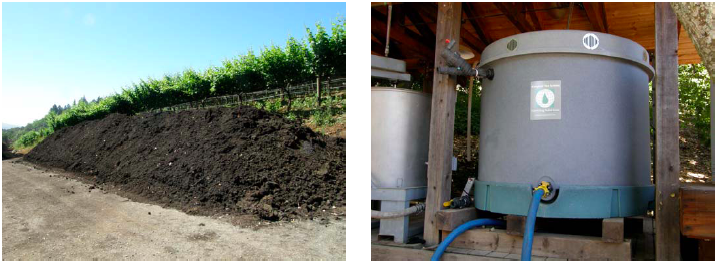 I tasted some individual 2008 clonal barrel samples from de Coelo Vineyard in the Sonoma Coast (www.princeofpinot.com/article/921/). The grapes were picked at about 23° Brix and finished fermentation at about 12.8% alcohol. I am fascinated with this vineyard as it produces wines of layered nuance and the first vintages in 2006 and 2007 were remarkably interesting wines reflective of a unique terroir. For comparison, we tasted the 2006 Kistler Bodega Headlands Vineyard Cuvée Elizabeth Sonoma Coast Pinot Noir which is sourced from a vineyard adjacent the de Coelo Vineyard. This wine, which received a score of 96-98 from the Wine Advocate, and now sells on the secondary market for close to $200, is a monstrous wine more like Syrah than Pinot Noir. Plush and darkly colored, the sweet dark fruit has an earthy, mocha and nutty undertone with notable chalky tannins. I prefer the direction that Soto has chosen for his Benziger de Coelo Vineyard Pinot Noirs because I believe the lower alcohols and more restrained use of new oak allows the terroir to speak. Visit the Benziger website at www.benziger.com for more information. The winery is quite busy and a popular spot among wine tourists but the wine enthusiast can find plenty to interest them here. The Biodynamic® Vineyard Tram Tour is a 45-minute close-up look at the Benziger Biodynamic vineyards, fermentation facility, and barrel caves followed by a special wine tasting. The winery is located at1883 London Ranch Road, Glen Ellen. 707-935-3017.
Carr Vineyards & Winery: The Latest ReleasesI featured this excellent producer of Pinot Noir in a recent issue of the PinotFile (www.princeofpinot.com/winery/1215). This urban winery (the winery and tasting room is located in downtown Santa Barbara) is under the direction of Ryan Carr who is also in charge of a vineyard management and development company that currently supervises over 100 acres of vineyards in Santa Barbara County. Carr Vineyards & Winery produces 3,000 cases of multiple varietals with a focus on the Sta. Rita Hills appellation. The two 2007 Carr Pinot Noirs reviewed last year from the 2007 vintage were very good and the four 2008 Pinot Noirs reviewed below are equally fine. All the wines are beautifully aromatic with engaging fruit and lively acidity. Prices are sensible.
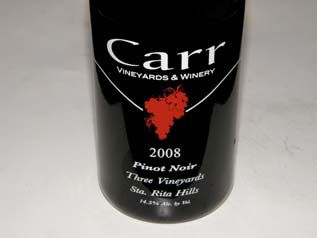 2008 Carr Vineyards & Winery Three Vineyards Sta. Rita Hills Pinot Noir 14.5% alc., 350 cases, $38. Released in March 2010. Sourced from Turner Vineyard, The Yard Vineyard and Lindsay’s Vineyard. Clones 777, Pommard, 115, 114. Aged 12 months in 15% new French oak barrels. · Shy nose initially, opening over time displaying aromas of black cherries, strawberries and sweet oak. Crafted in a lighter vein and soft in the mouth with vivid flavors of red berries, cherry skins, sandalwood, vanilla wafer and a touch of citric lift on the finish. A tasty, solid wine that will find many fans. Good (+).
2008 Carr Vineyards & Winery Turner Vineyard Sta. Rita Hills Pinot Noir 14.5% alc., 210 cases, $40. Released in March 2010. From a 21-acre vineyard located in the northern part of the Sta. Rita Hills AVA. The vineyard is owned by Henry Schimberg and farmed by Ryan Carr who planted the vineyard in 2000. Clones 777 and Pommard. Aged 12 months in 20% new French oak barrels. · Scent of spiced berries, Herbs de Provence, oak and mint. Generous core of cherry and raspberry fruit with savory herbs in the background and a note of citrus peel on the finish. Soft and smooth in the mouth with vibrant acidity and some persistence on the finish. A fine table wine. Good (+).
2008 Carr Vineyards & Winery The Yard Sta. Rita Hills Pinot Noir 14.5% alc., 98 cases, $45. Released in March 2010. The Yard Vineyard was planted by Ryan Carr in 1998 and is located at the northern tip of the Sta. Rita Hills AVA. The original owners ceased farming the vineyard so it was never harvested, but in 2005 Bryan Babcock leased the vineyard and it is now in full production. Clones 114 and 115. · The nose is more savory than fruity with notes of underbrush, spice, black tea and oak. Very tasty, even striking, flavors of fresh cherries and strawberries, with undertones of melon and brioche. Very smoothly textured with knife like acidity on the citric finish. I really like the intense strawberry flavor of this wine. Very good.
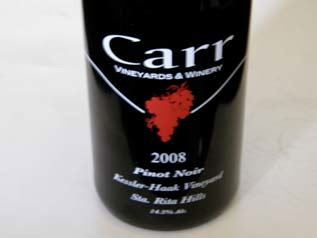 2008 Carr Vineyards & Winery Kessler-Haak Vineyard Sta. Rita Hills Pinot Noir 14.5% alc., 98 cases, $50. Released in March 2010. The 29-acre Kessler-Haak Vineyard was established by Dan and Ellen Kessler in 2004 and cultivated by Ryan Carr. The 2008 harvest is the first from this site. Yields were a ridiculously low .19 tons per acre. Clones Pommard, 2A, 113 and 667. Aged 12 months in 15% new French oak barrels. · The intoxicating aromas really explode over time in the glass offering nuances of raspberries, black cherries, spice box and mocha java. Delicious essence of cherry-berry pie with hints of vanilla cream, anise and dark chocolate. Very soft, even sensual, in the mouth. This is a wine you can cozy up to like a warm blanket, embracing its comforting gratification. On my 2010 All-American watch list.
The Carr Vineyards & Winery tasting room in Santa Barbara is open daily. The wines are also available from the online store at www.carrwinery.com.
Small Sips of Pinot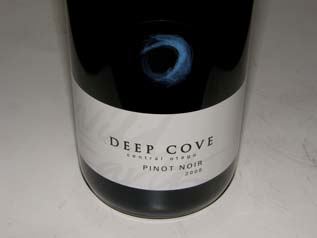 2008 Deep Cove Central Otago Pinot Noir 13.8% alc., $19, screw cap. Imported by San Francisco Wine Exchange, San Francisco, CA. A confusing new name and label for Pinot Noir from Wild Earth Vineyards Ltd., who produced highly touted Pinot Noirs in 2006 and 2007 under the Wild Earth label. Sourced from estate Bannockburn vineyards and blend with grapes from other Central Otago vineyards. · The strawberry and black cherry fruit is on the ripe side with a subtle roasted quality. Still quite tasty in a simple, straightforward way. Velvety in the mouth with gossamer tannins. An easy going drink that delivers at a value price.
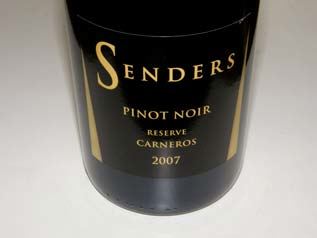 2007 Senders Wines Las Brisas Vineyard Reserve Carneros Pinot Noir 14.7% alc.. · Enticing aromas of ripe dark stone fruits with hints of oak toast, smoke and violets. Flavorful essence of fresh picked dark cherries and berries accented by a subtle grilled note. The tannins and acidity are more harmonious compared to the regular bottling and the silky smooth mouth feel is a come on. Veers to the edge of being over ripe, but falls short. The fruit really makes a statement. Very good.
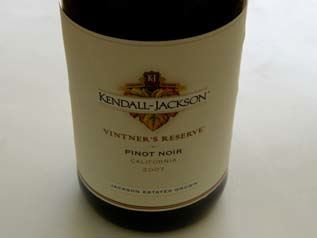 2007 Kendall-Jackson Vintner’s Reserve California Pinot Noir 13.5% alc., pH 3.68, $15.69. Kendall-Jackson, who cultivates 12,500 acres of vineyards, is reputedly the largest grower of Pinot Noir in California and the Vintner’s Reserve Pinot Noir is the best selling Pinot Noir in the United States. This wine is 92% Pinot Noir with a splash of Petite Sirah, Syrah and Zinfandel for added color and complexity. Sourced from multiple California vineyards from Santa Barbara County to Mendocino County. 86% aged for 9 months in French oak barrels (some American oak barrel aging as well). The winemaster is Randy Ullom. Moderate reddish-purple color in the glass. Pleasing slightly confected · Moderate reddish-purple color in the glass. Pleasing slightly confected aromas of strawberries and cherries with supporting oak and cedar. Modestly intense cherry and berry fruit core veering toward cherry Life-Savor flavor. Soft in the mouth with slippery tannins. A fine training wheels Pinot that is highly drinkable and a stellar value. Your wine impaired in-laws will love this wine. Good.
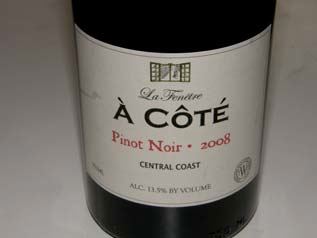 2007 La Fenêtre À Côté Central Coast Pinot Noir 13.5% alc., $20. · Relatively light garnet color in the glass. A woodsy, slightly funky nose with hints of oak and bay leaf. A simple, lighter-styled wine featuring redder cherry and berry fruits with a cherry candy and slight green note in the background. Soft tannins make for easy drinkability. This wine can fill in at the dinner table with its brisk acidity. Decent.
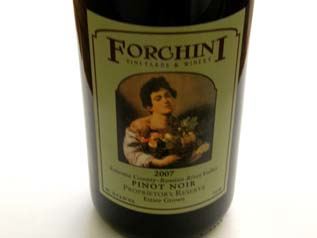 2007 Forchini Vineyards & Winery Proprietor’s Reserve Estate Grown Russian River Valley Pinot Noir 14.5% alc., $26. From the estate River Terrace Vineyard. The winemaker is James F. Forchini. · Complex nose featuring scents of red fruits, dried rose petals, spice, underbrush and balsam. Ripe dark red stone fruits with added interest from flavors of black tea and grilled meats. Moderately rich with some ragged tannins and a dry cherry-laden finish. Good.
2007 Senders Wines Las Brisas Vineyard Carneros Pinot Noir 14.3% alc., $30. · Lively aromas of black cherries and raspberries grab your attention over time in the glass, backed by a vegetal green bean note. Dark red fruited including currants and roasted plums fan out nicely on the palate with a refreshing lift of acidity on the back end. Good.
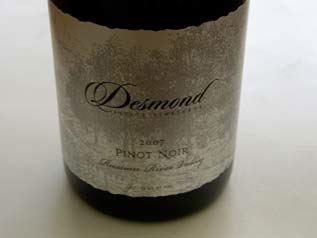 2007 Desmond Estate Vineyards Russian River Valley Pinot Noir 13.8% alc., pH 3.69, 80 cases, $36. A field blend of Dijon clones 115, 667 and 777 from the Desmond Estate Vineyard. Aged 10 months in 35% new French oak barrels. · Interesting nose with fresh scents of cherries, mint, oak and leather sole. Medium-weighted flavors of black cherries and black raspberries with a hint of green tomato and red licorice. Nicely composed with mild tannins and bright acidity, but lacking mid palate impact. Good.
Pinot Briefs18th Annual Catalan Festival at Gloria Ferrer Caves & Vineyards This celebration on July 24-25, 2010, honors the winery’s Spanish roots and the opening of the winery in July 1986. The colorful Festival features authentic Catalan and Spanish dishes such as paella from many of the Bay Area’s best restaurants. Gloria Ferrar’s sparklers and still wines are featured as well, along with some of the Ferrer family’s collection of Spanish wines. Tickets are $50. RSVP online at www.gloriaferrer.com. Direct-to-Consumer Wine Shipments With America’s 6,700 wineries and media focused on House Resolution H.R. 5034, a study by the Ship Compliant of Colorado and Wines & Vines Industry Database found that 2.6 million cases were shipped direct-to-consumer for the year ending in March, or about 1% of the total annual U.S. wine sales of 251 million 9-liter cases. These cases represent a tiny portion of wine sales, but account for a significant percentage of smaller winery revenues. Napa Valley wineries sell more direct-to-consumer wine than any other U.S. wine region. U.S. wineries create 1.1 million jobs in American and have a $162 billion economic impact on the American economy. For more information, contact www.wineinstitute.org. Hugh Chapelle Moves to Quivira Vineyards Noted Sonoma County winemaker Hugh Chapelle, who has over 20 years of winemaking experience, was named winemaker for Quivera Vineyards & Winery beginning July 1, 2010. Chapelle had been the winemaker at Lynmar Estate in the Russian River Valley since 2004 and before that, was winemaker at Flowers Vineyard & Winery on the Sonoma Coast. Chapelle replaced Steven Canter, who took a winery position in Oregon. Quivera specializes in Rhone varieties, Zinfandel and Sauvignon Blanc. 2010 Dietary Guidelines May Redefine “Moderate” Alcohol Consumption The U.S. government is currently considering a redefinition of moderate alcohol consumption. A report released June 15 indicated a suggestion to define moderation as an average daily intake of up to one drink for women and two for men, with no more than three drinks for women on a single day and four for men. The wording, “Average daily intake,” is an attempt to clarify the results of many epidemiological studies that may report data tallied by drinks per week so that an average of one drink a day could mean the person had no drinks on any day except Saturday when they imbibed seven. The Guidelines want to clarify the responsible daily use of alcohol. The final Guidelines will be published at the end of the year. Surprising Report at Oregon Wine Marketing and Sales Conference Chriss Oggenfuss of Oggenfuss Wine Marketing in Napa reported that 78% of consumers trust other consumers’ comments the most. He said the top 20 wine bloggers have a larger audience and more influence than Wine Spectator. All the speakers’ Power Point presentations from the Conference are posted at www.rvwinegrowers.org.
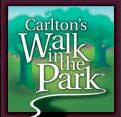 Carlton’s Walk in the ParkThis annual event is to be held July 31-August 1, 2010 at Wennerberg Park in Carlton, Oregon. A benefit for local charities, this festive event combines artists and musicians with outstanding Yamhill Countuy restaurants and wineries. Well-known Yamhill-Carlton wineries pouring include Anne Amie, Belle Bente, Carlton Winemaker’s Studio, Elk Cove Vineyards, The Four Graces, Ken Wright Cellars, Penner-Ash, Scott Paul Wines, Solena Cellars, Soter Vineyard, and Stag Hollow Wines. A beer garden is provided by McMenamins. Tickets are $15. Visit www.CarltonsWalkinthePark.com for information. International Pinot Noir CelebrationThere are still a few tickets available for this storied event in McMinnville, Oregon. $975 (full weekend), $150 (Salmon Bake), $125 (Sparkling Finale Brunch). A three-day party for Pinot lovers. Kudos to Gary Farrell Farrell recently sent out a letter to his mailing list stating what we have known for some time, namely, that people are resisting spending “more than is necessary” for quality wine. Sales of the most expensive luxury wines have slowed dramatically. Farrell believes, “This is a healthy correction in our industry,” and goes on to say, “As talented winemakers and growers partnered to produce highly acclaimed wines, it seemed there was no limit to what consumers would pay. Thankfully this trend is behind us, as we see top producers wisely reacting to current market conditions by resetting prices to more reasonable and sustainable levels.” Farrell predicts that for the first time in nearly a decade, there will be reduced demand and lower prices for grapes from even the finest and most coveted vineyards. Accordingly, Farrell reset the price of his Alysian 2007 Russian River Valley Selection Pinot Noir to $40 a bottle. For those that had already purchased this wine at the higher release price, he offered to provide a credit to one’s account or send a refund check. I believe this is a move in the right direction and will endear him to his customers, although I would have set the price even lower, feeling that the consumer would be more inclined to by the wine at $35. Joel Aiken Leaves Beaulieu Vineyard Aiken retired as vice president of winemaking at Beaulieu Vineyard this January after 27 years at the winery to devote himself to his own label, Aiken. He plans to specialize in Howell Mountain Cabernet Sauvignon and Sonoma Mountain Pinot Noir. He will continue to consult for Beaulieu’s Gerges de Latour Private Reserve Cabernet Sauvignon.
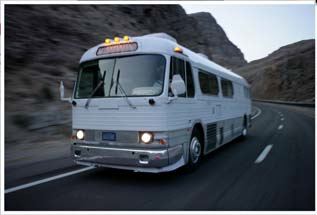 Kai Schoenhals Diamond Lil Schoenhals left movie production to design and build restaurants, bars and hotels in 2000, often using landmark buildings to revive neighborhoods. He and a partner have retrofitted a 1957 Greyhound bus with a kitchen and seating for 16. This summer, he is transporting the table to the farm. With Schoenhals as on board sommelier, the bus and its guests travel Sonoma County to pick up supplies for that night’s dinner, often asking the guests where they want to go. Then parked in a vineyard destination, diners enjoy a gourmet dinner with local ingredients and wines. Check it out at www.impakd.com. The Final Word I often get asked about the quality of recent vintages for Pinot Noir in California and Oregon. I dislike generalizations about vintages, but in response to these inquiries, I offer the following in the simplest of terms. Buy the 2007 vintage from California. Buy the 2008 vintage from Oregon.
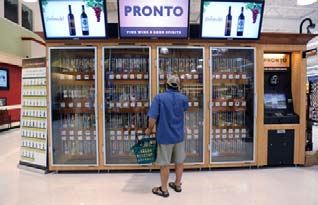 Wine Vending Machine Pennsylvania now has wine bottle vending machines in two grocery stores as part of a pilot program. An ATM-type device sits at one end. The customer chooses a wine, swipes their ID, blows into a breathalyzer and looks into a camera. A state employee in Harrisburg remotely approves the sale after verifying that the buyer matches the photo ID. The wine kiosks are closed on Sunday and holidays. This seems like a daunting and unglamorous way to buy wine. Only in Pennsylvania! Wine Wednesday Goes Awry. Another very funny piece of writing from the Bruliam Wines blog: www.bruliamwines.com/2010/07/wine-wednesday-goes-awry/. Sonoma-Cutrer Opens Tasting Room For the first time, Sonoma-Cutrer Winery in Windsor, Sonoma County, opened its doors to the public, featuring a newly renovated tasting room and offering tours of its winery. The tasting center will be open Thursday-Monday ($10) and tours with tasting ($25) will be offered by appointment. Sonoma-Cutrer is best known for its consistently fine Chardonnays and is the number one choice in restaurants by the wine buying public. The winery also produces a very credible Pinot Noir. Visit www.sonomacutrer.com. WineWeb Mobile Winery Tour Planning Tool WineWeb.com has released a mobile version of its winery tour planning tool, with support for iPhone, iPad and Android devices. The planner includes optimized tour routes and driving directions plus appointment scheduling and winery research tools. There is a directory of over 35,000 wineries covering every wine region in the world. The winery tour planning tool is available at wwwm.WineWeb.com. Bien Nacido Vineyard of the Year 2010 At the recent VIP awards ceremony at this year’s California State Fair, Bien Nacido was given the “California Vineyard of the Year” award as a vineyard that has consistently over several growing seasons produced grapes that have contributed directly to wine of superior quality and marketability within commercial sales systems and among fine wine judging. Visit www.biennacidovineyards.com.
Did You Catch That License Plate?
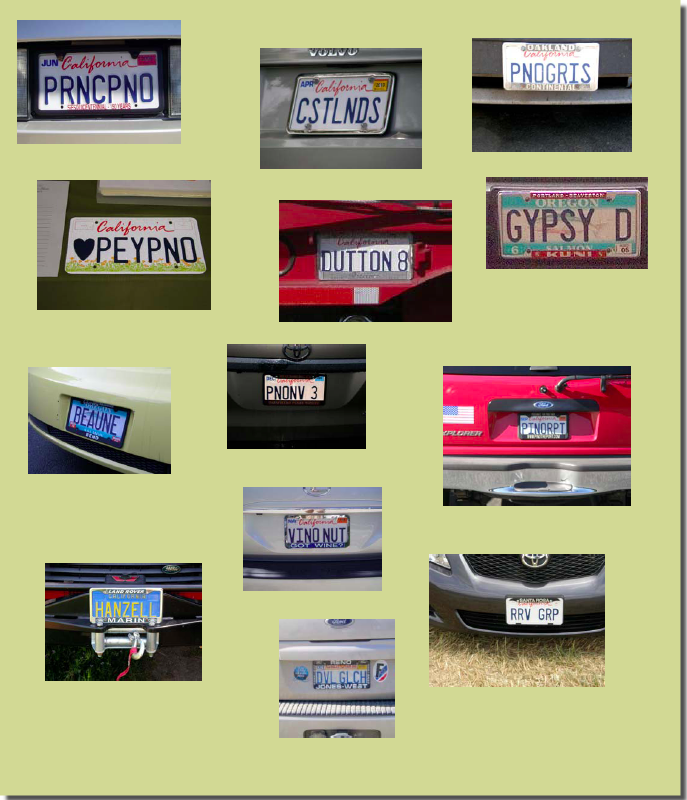 |